SVTP Coverage of NAIAS 2014 : The Detailed View
Attention to details is an important quality in automotive engineers. Let's take the time to recognize their efforts.http://www.svtperformance.com/forum...7-svtp-coverage-naias-2014-detailed-view.htmlhttp://www.svtperformance.com/forum...7-svtp-coverage-naias-2014-detailed-view.html
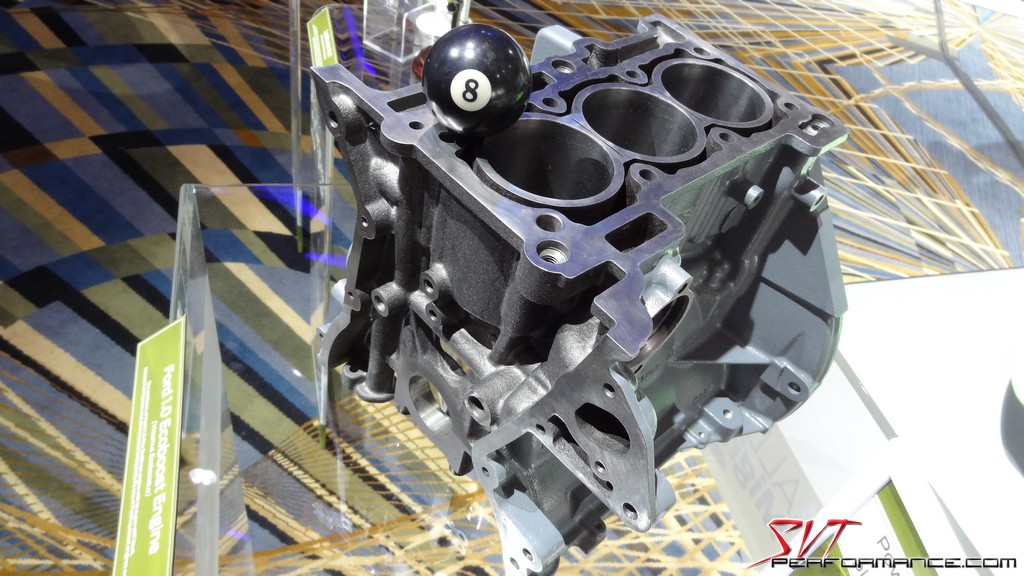
Attention to details is an important quality in automotive engineers. Let's take the time to recognize their efforts.http://www.svtperformance.com/forum...7-svtp-coverage-naias-2014-detailed-view.htmlhttp://www.svtperformance.com/forum...7-svtp-coverage-naias-2014-detailed-view.html

There are many different factions the automotive enthusiast community. We draw divisions based on vehicle type (cars or trucks), origin (domestic or import), application (drag racing, road course, or cruiser), and brand just to name a few. The hobby divisions go even deeper than that. Personally, I tend to gravitate towards what some may call the "geeky" side of automotive enthusiasm.
I love to study the details. To me the engineering details of the various components of a vehicle are often more interesting than the final vehicle itself. So when a show like the North American International Auto Show comes around I always get lost in the intricate displays and cutaway engines. So for my fellow car geeks, I wanted to create this article just for you. I hope you enjoy it as much as I enjoyed creating it.
Ford had a large display featuring many of their weight saving manufacturing techniques. This panel is made from traditional spot welded stamped steel.
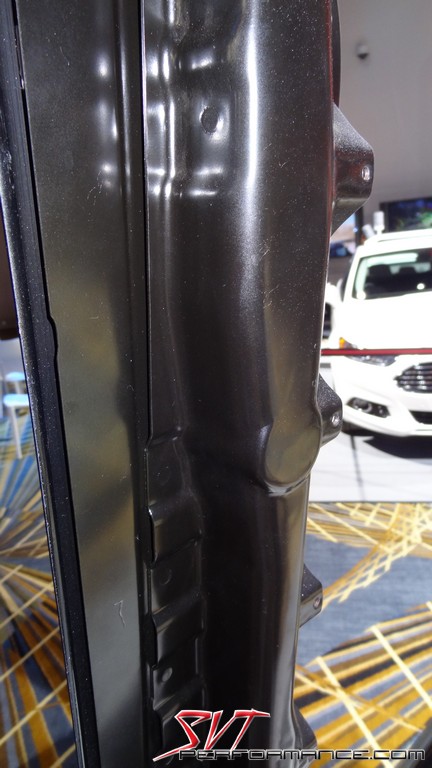
The above panel's lighter counterpart features several aluminum extrusions.
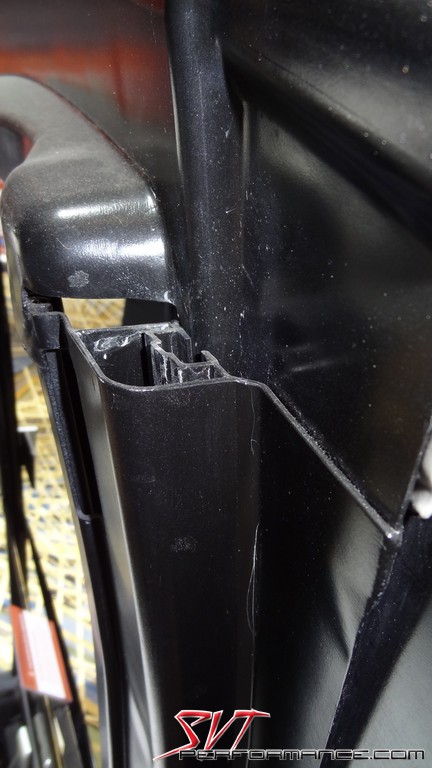
This single roof panel manufactured with aluminum in place of steel saves over 25 pounds.

Taking it a step further, Ford also had a similar panel made with magnesium extrusions.

Here you can see its construction.
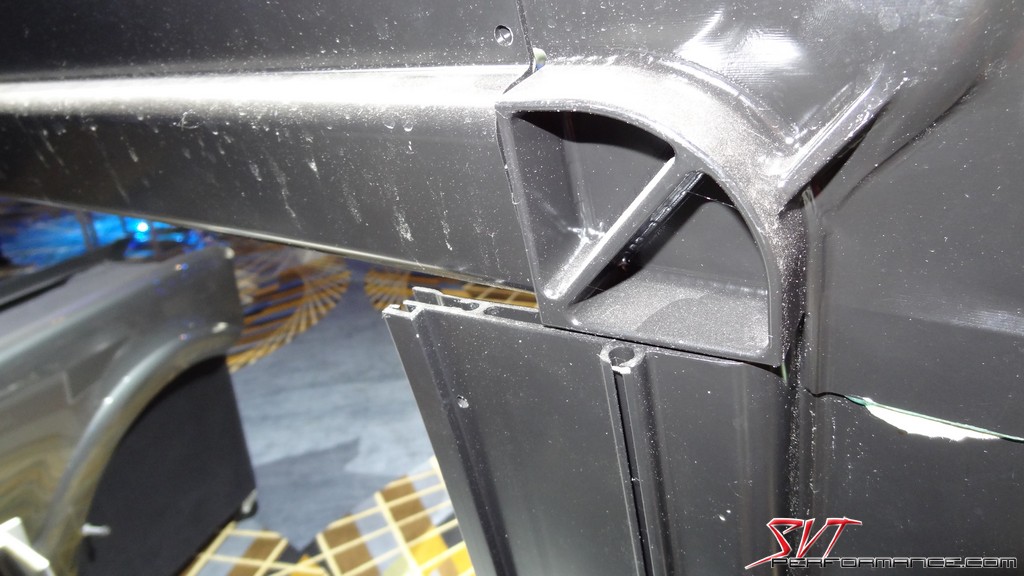
Ford has been looking in places you may not think of in order to cut weight. One o these HVAC ducts is made from plastic, the other is foam and it easily weighted half as much as the other.
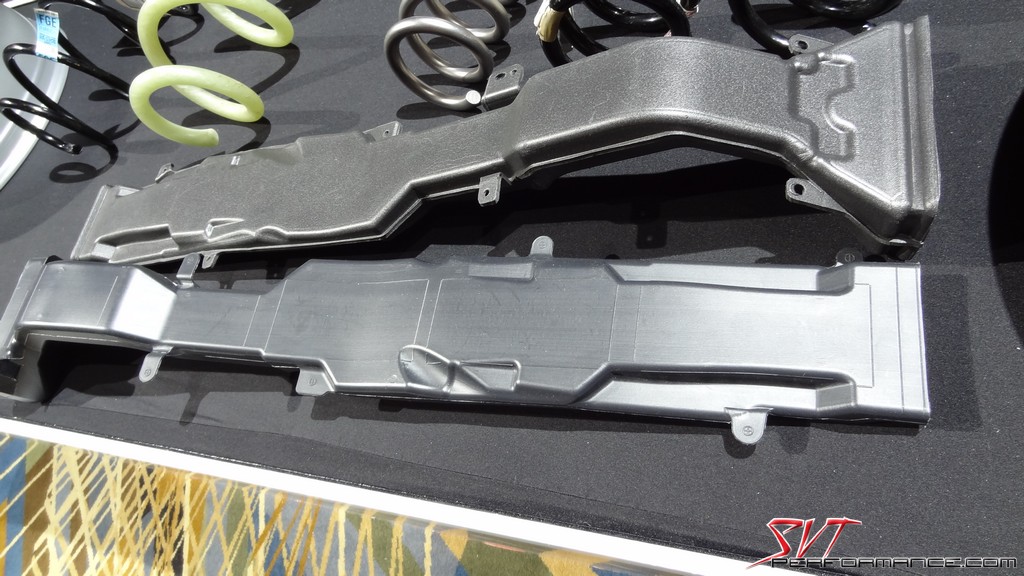
In a few years you may be seeing carbon fiber wheels offered on Fords.
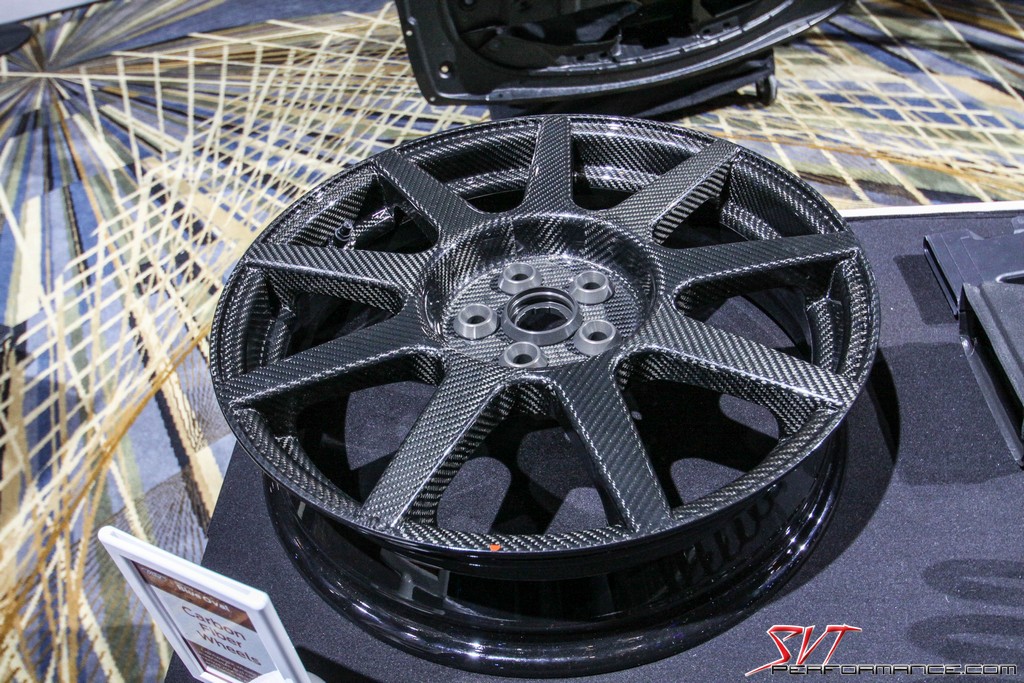
Titanium springs may be a bit cost prohibitive on a main line vehicle, but I could see them being offered in an application where every pound counts.
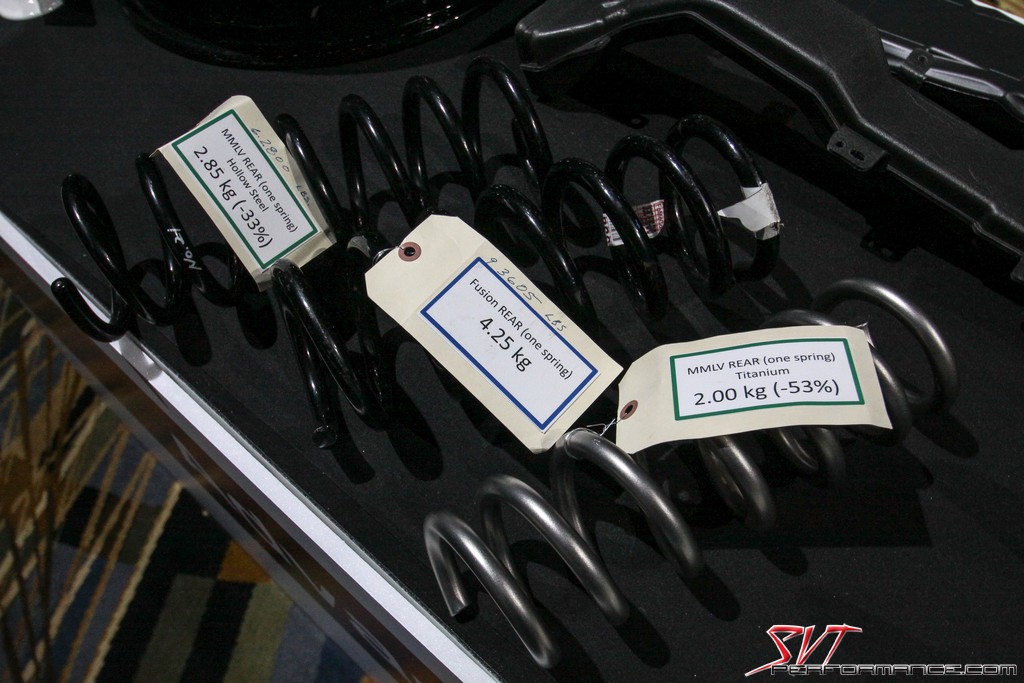
A synthetic composite, fiber glass for lack of a better term, is a very interesting proposition.

Ford has invested heavily in its rabid prototyping capabilities. It allows for much faster development at a substantially lower cost than traditional methods.

This is the 1.0L EcoBoost I-3 engine block. Word is a Ford engineer took one of these to Europe in a carry-on bag.

This is a cut-away model of the 2.3L EcoBoost I-4 that will be available in the 2015 Mustang.
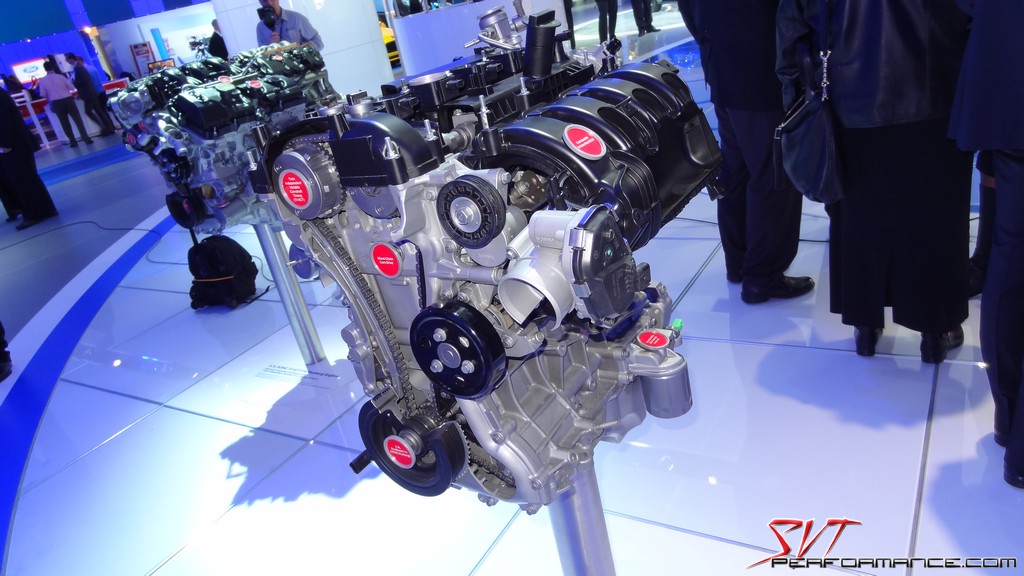
The 2.3L has a balance shaft that is chain driven off the crankshaft.
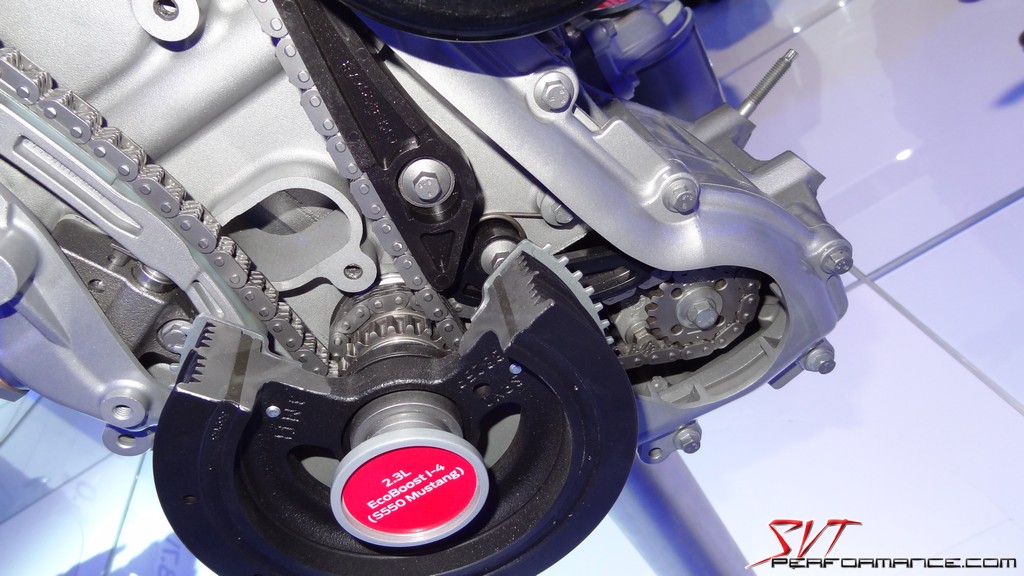
It's composite manifold is a well made piece that almost looks like half of a Cobra Jet intake manifold.
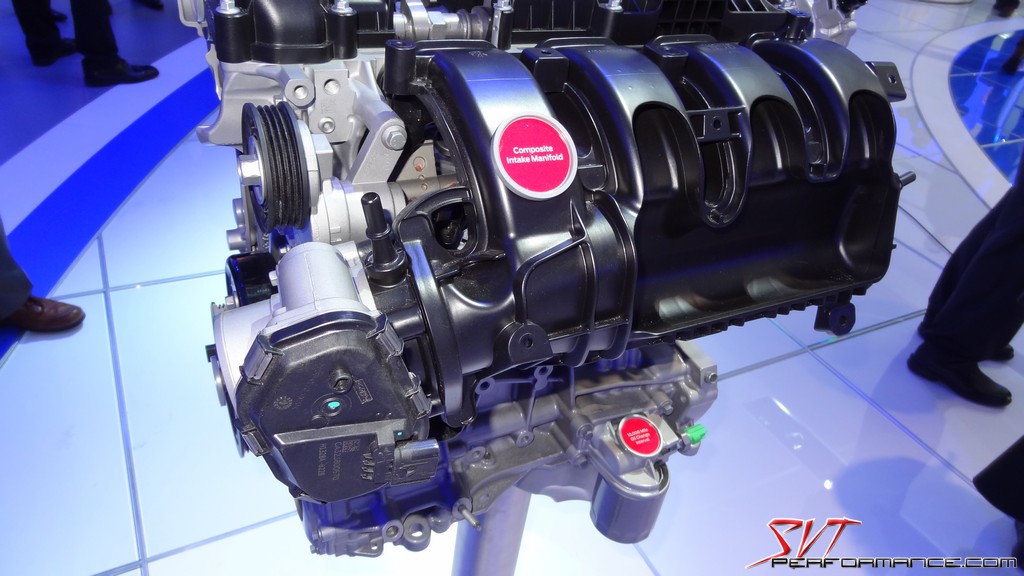
Just like the Coyote V8, the EcoBoost features Ford's Twin Independent Variable Camshaft Timing system.
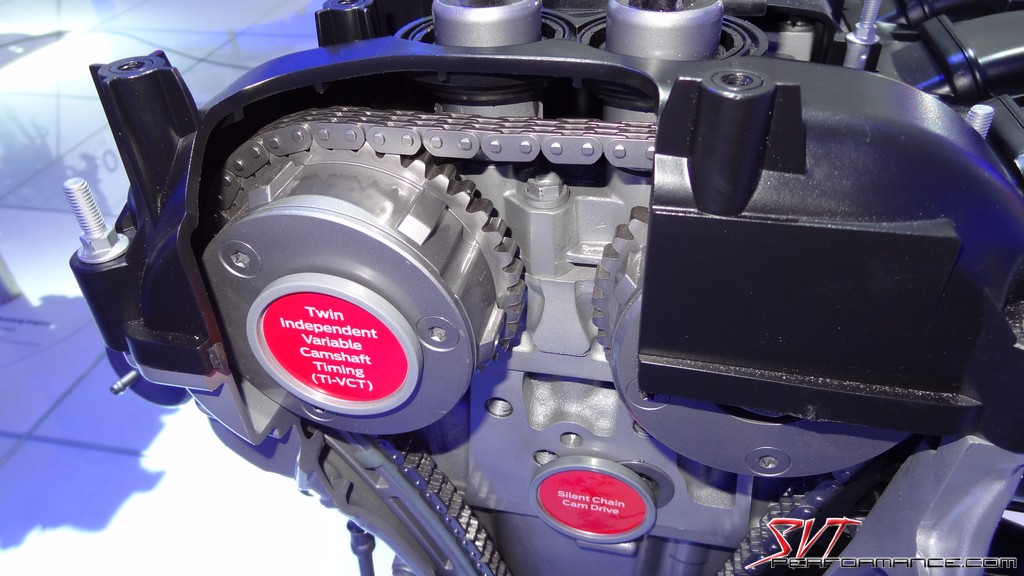
The I-4 also sports cast iron camshafts.
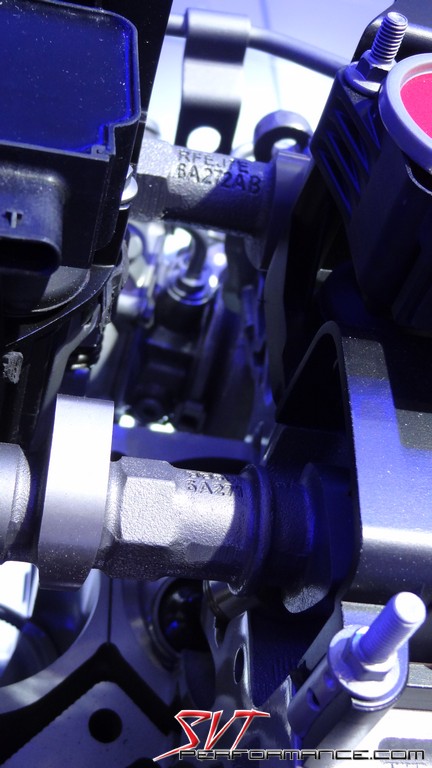
Sadly, the little turbo engine does not appear to come with an integrated oil cooler.
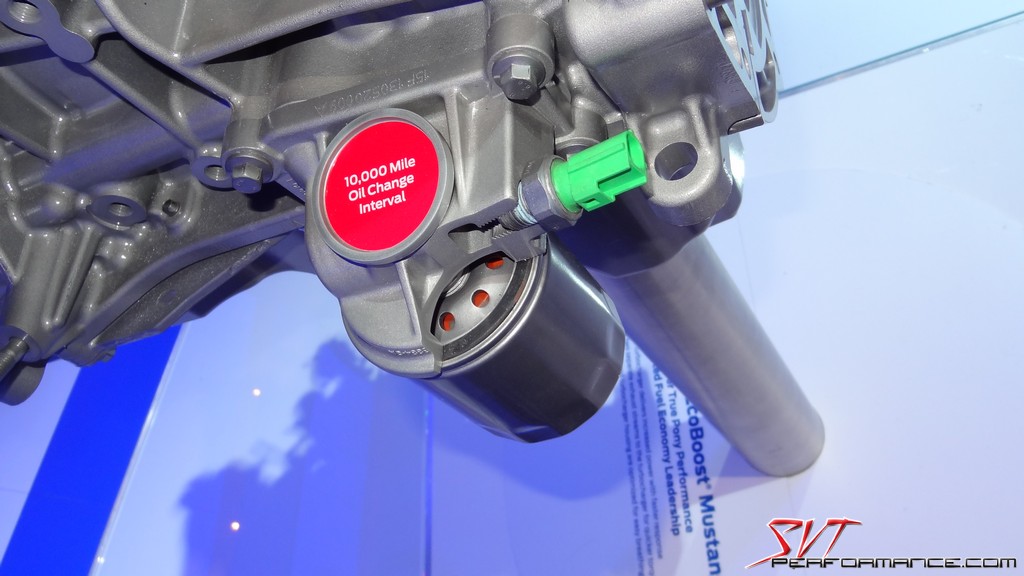
This module on the back of the cylinder head appears to be a vacuum pump.
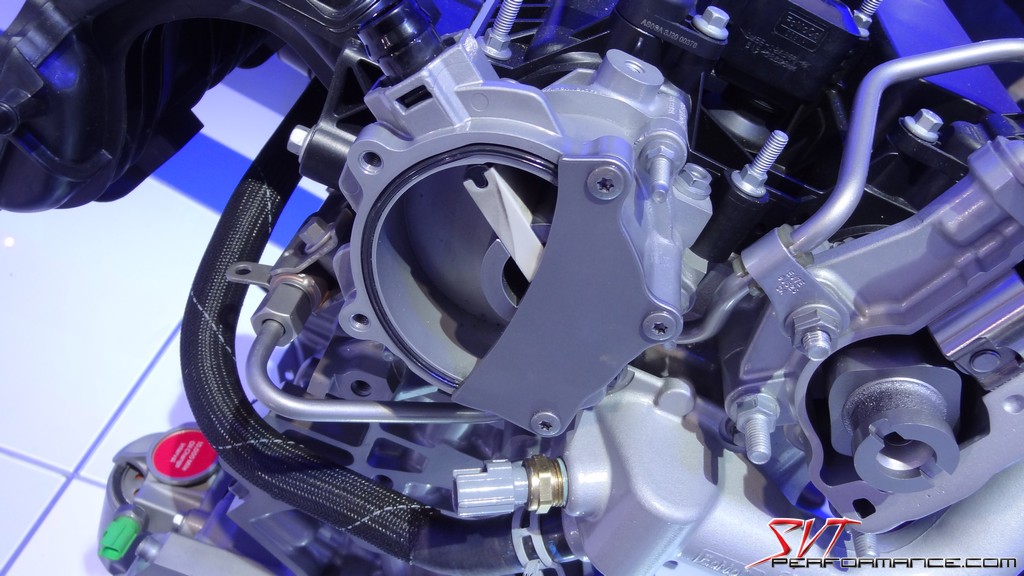
The EcoBoost's high-pressure fuel pump has a roller lifter that rides on its own dedicated four-peak camshaft lobe.
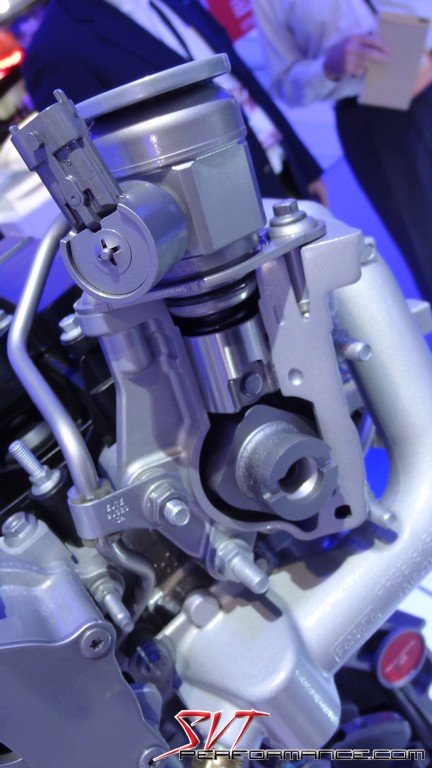
I'm glad to see an aluminum casting used for this coolant line.
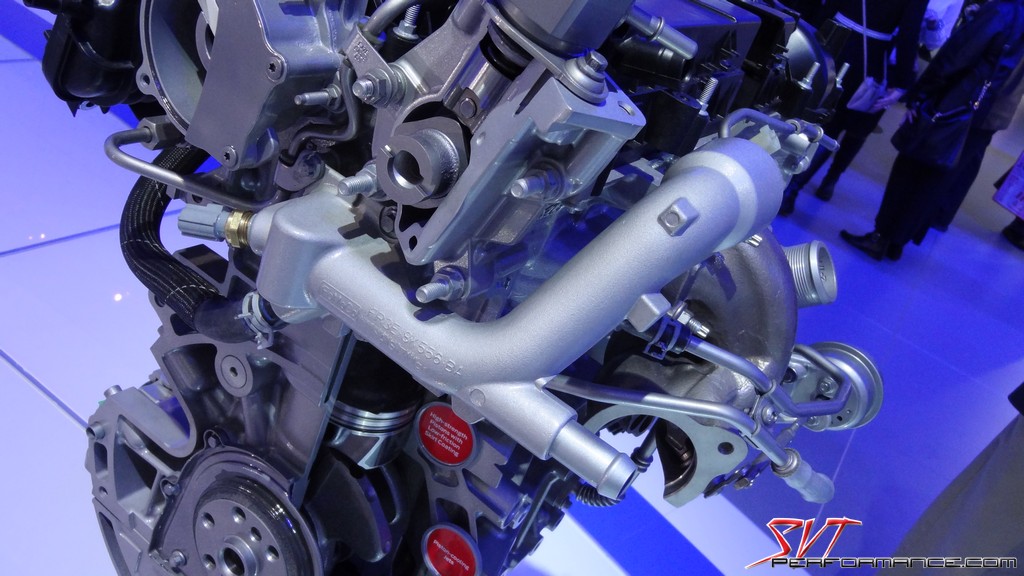
The Mustang version of this engine is supposed to feature a forged crankshaft and forged rods, which should make it pretty stout.
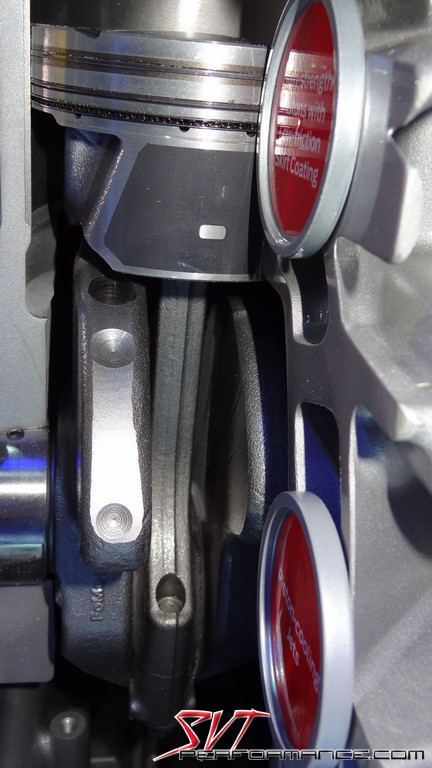
The EcoBoost lacks a traditional exhaust manifold. By casting it into the head Ford saves weight and cost.
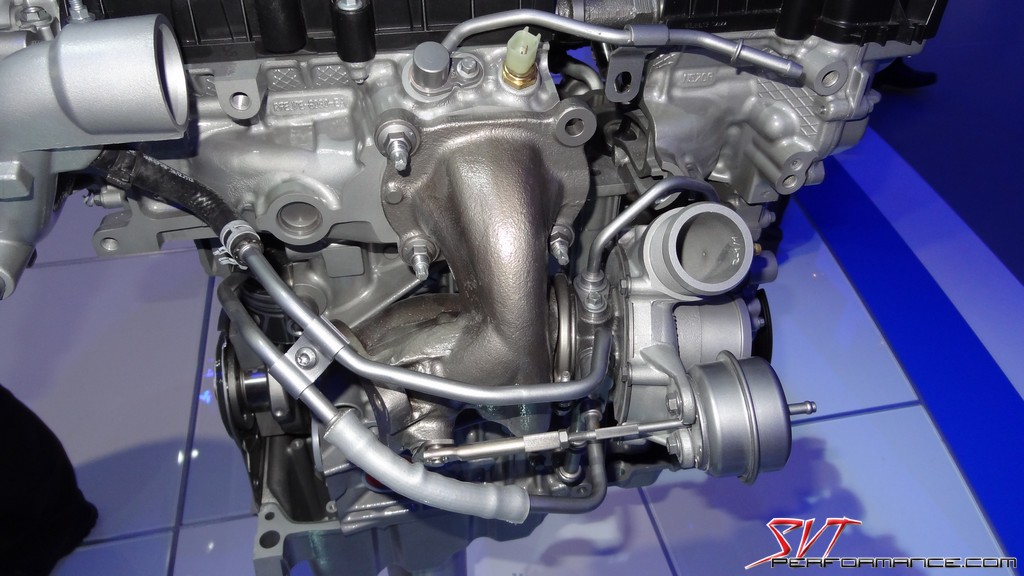
This turbo should make for an excellent torque curve.
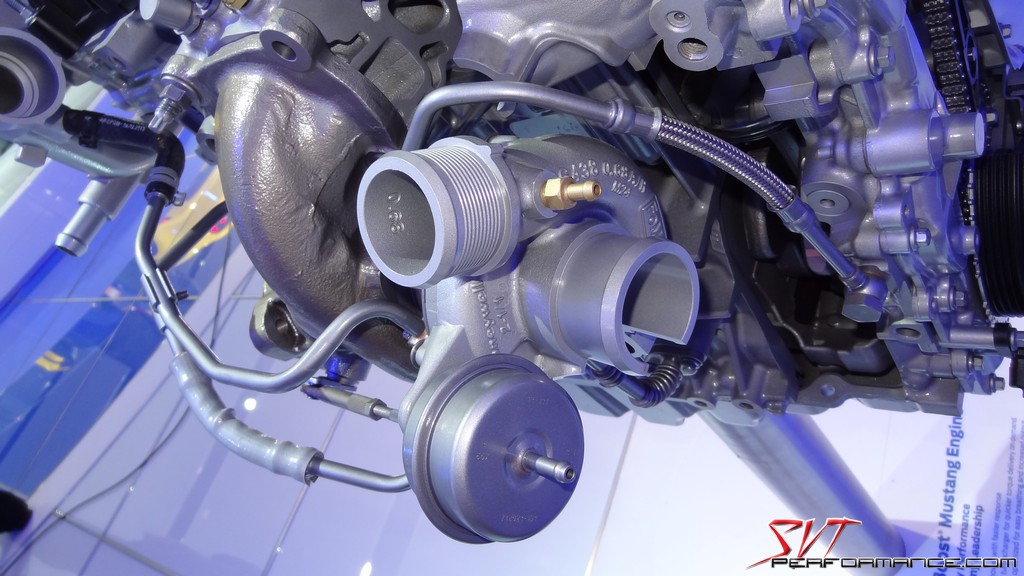
It may be small, but it should pack a nice punch.
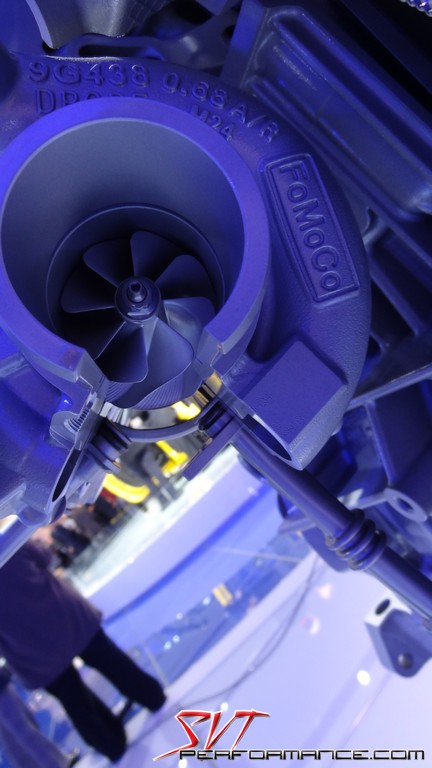
Here you can see the twin-scroll design of the exhaust housing.
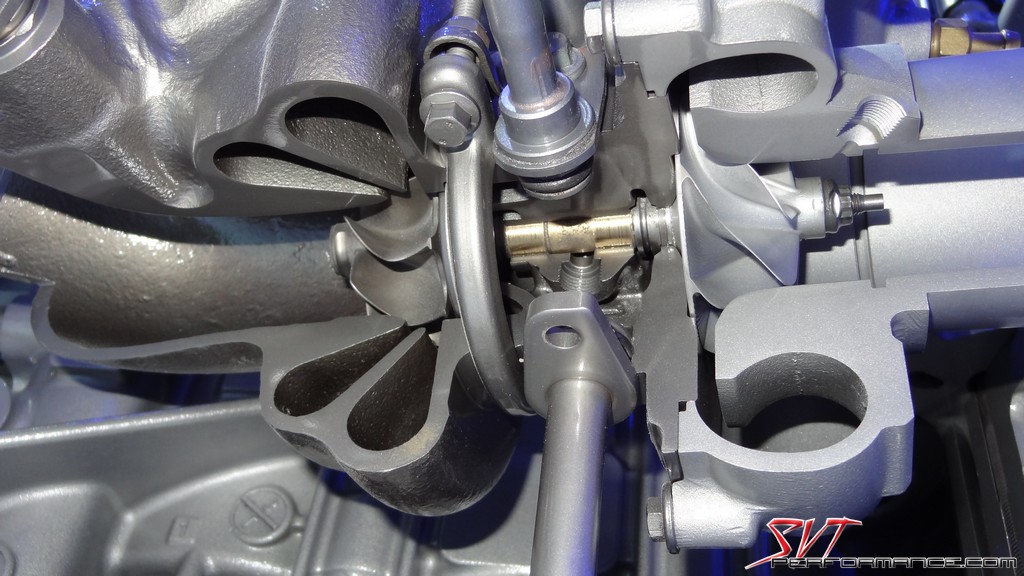
Looks like the EcoBoost will have a 6 bolt crank.
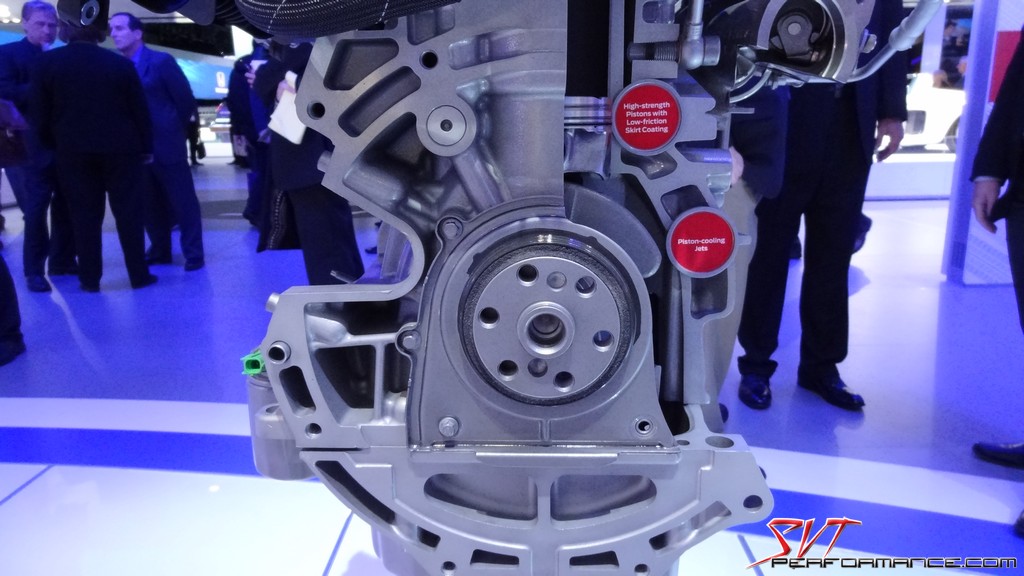
The 2.3's rods have a tapered small end that is very similar to those found in the 5.8L Trinity engine in the 2013-14 SVT Shelby GT500 Mustang.
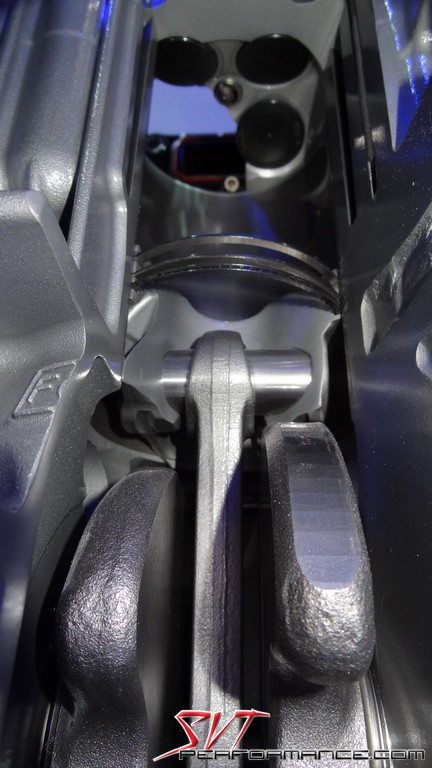
This is one of the EcoBoost's direct injectors.
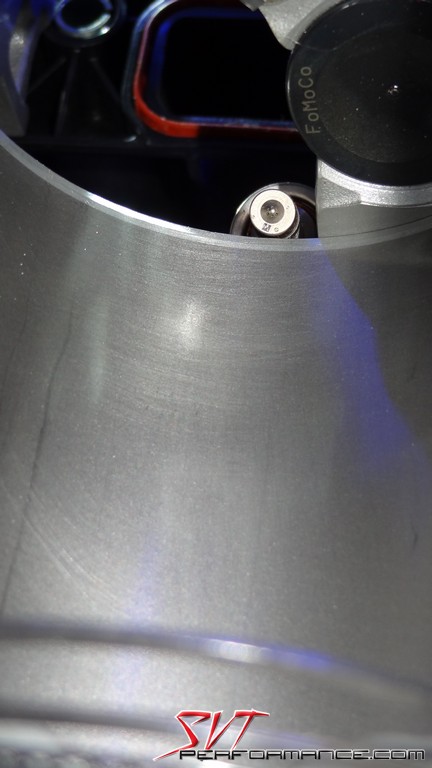
Looks like the S550 code name has made its official debut.
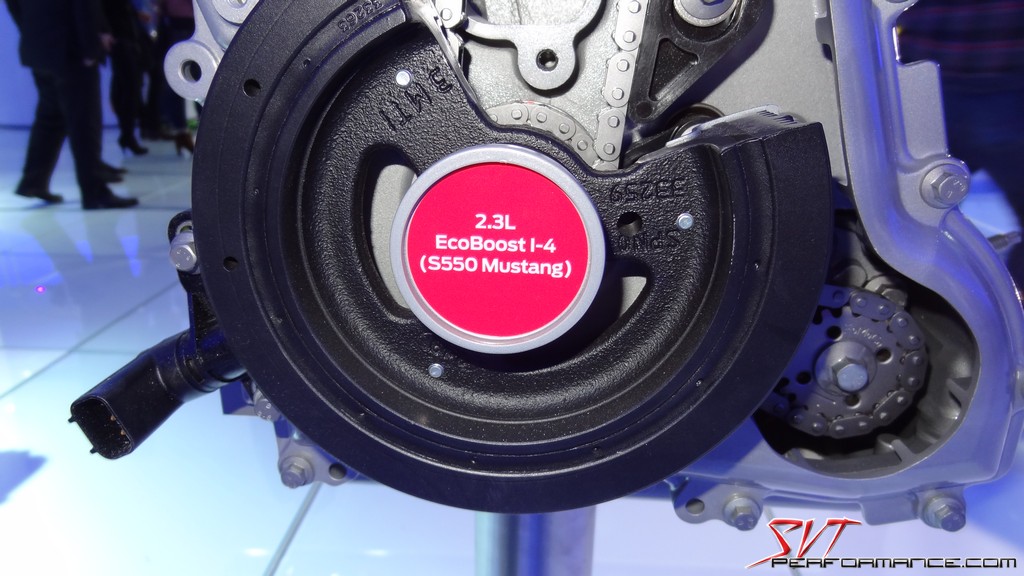
The combustion chamber of the 2.3L EcoBoost.
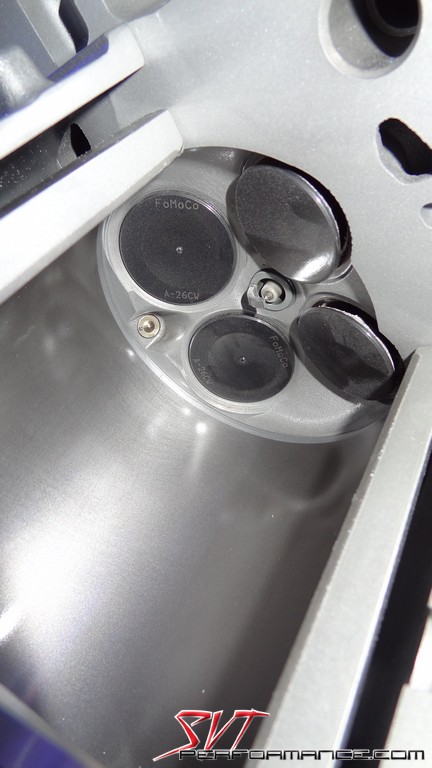
An up-close look of a 2.3's connecting rod.
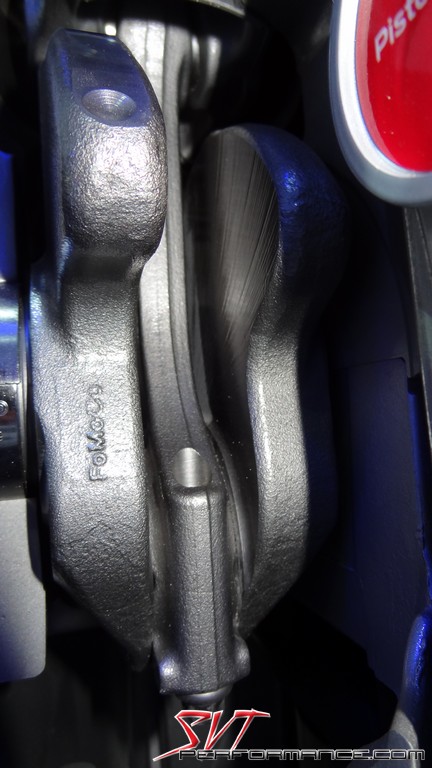
It looks like Ford has high hopes for this engine in the Mustang platform.
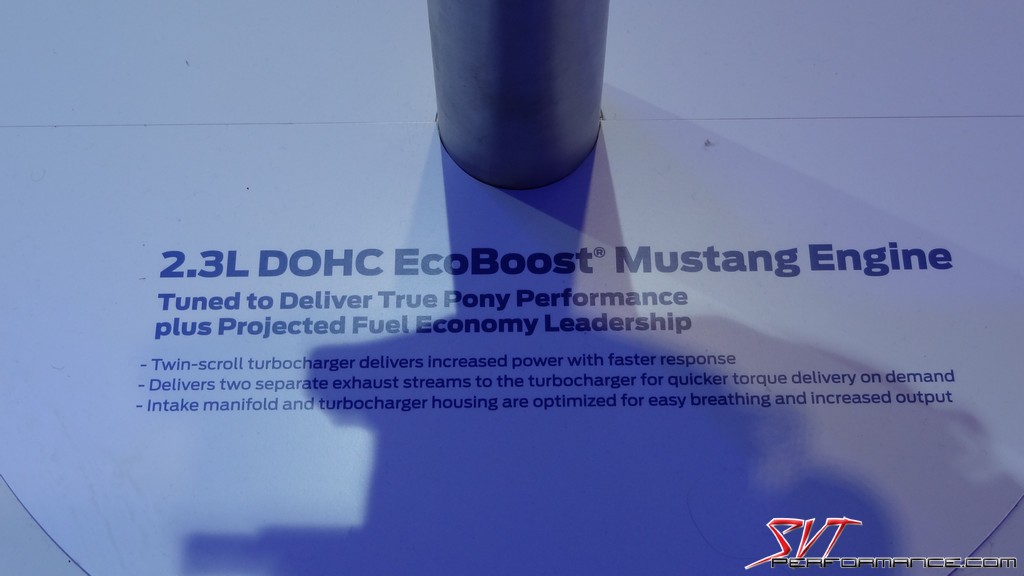
The Mustang's 3.7L V6 appears to be unchanged.
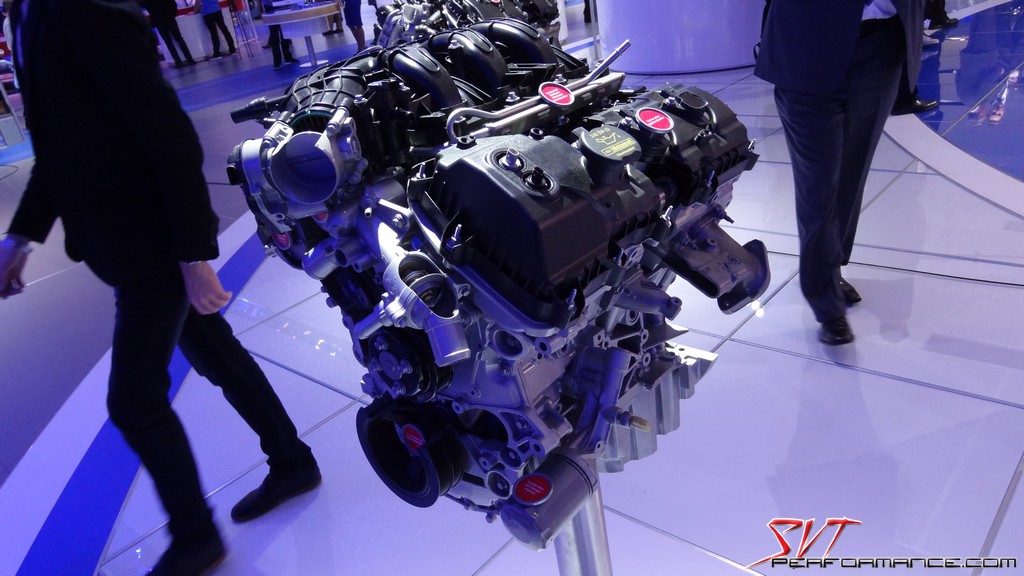
We know that the 2015 Mustang's Coyote V8 will be receiving a new intake manifold, but this seems to be the same engine model we have seen since the Coyote's debut.

You can see a piston oil squirter that the Coyote featured in the 2011 and 2012 model years.
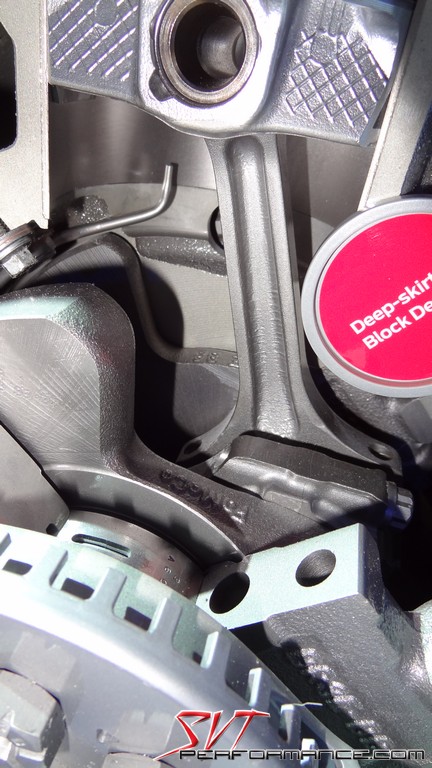
The Coyote block has decently thick cylinder walls.
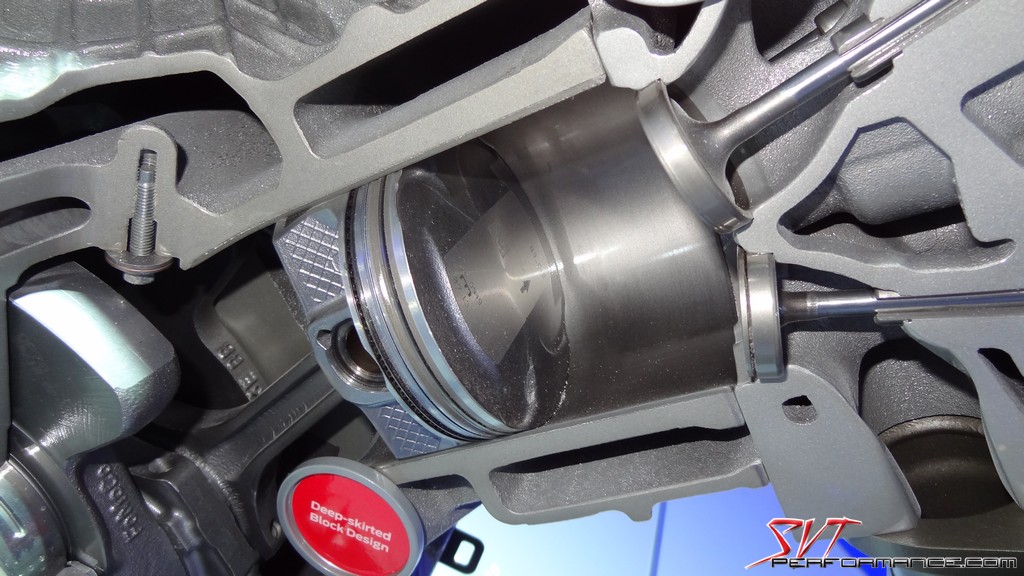
This engine has been the most popular performance platform in the Mustang since the original 5.0L V8.
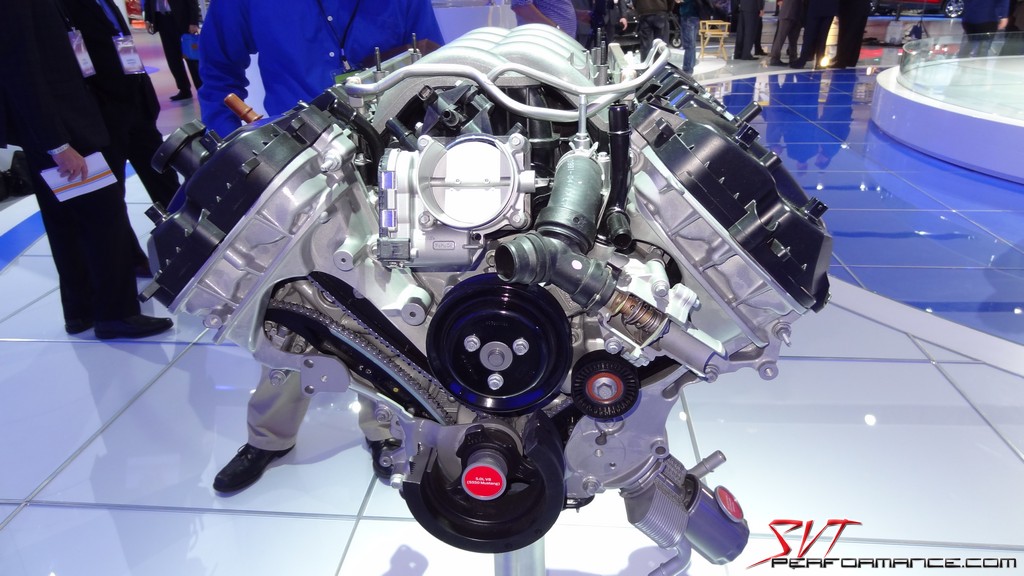
An oil cooler is a good upgrade if your Mustang didn't come with one from the factory.
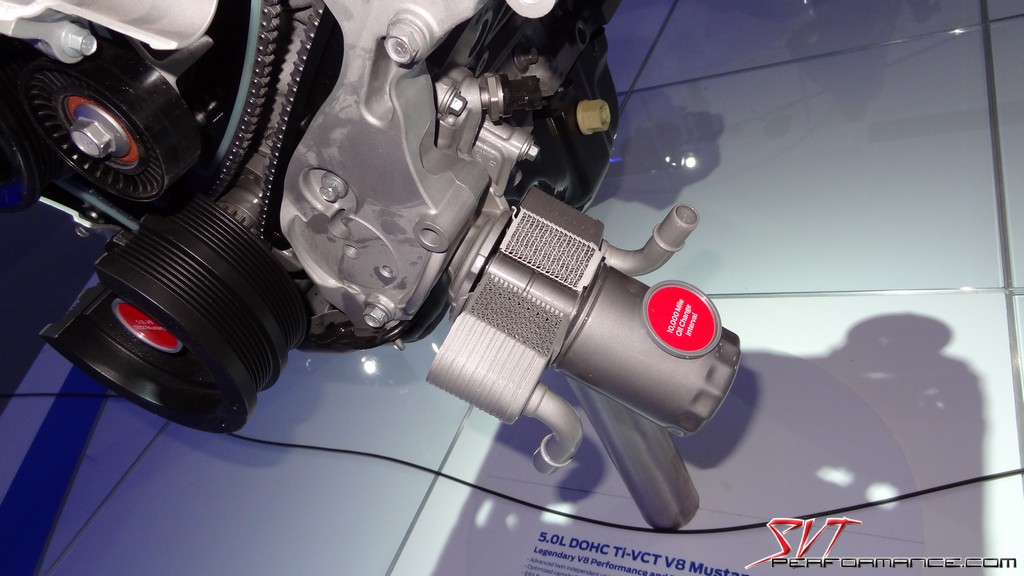
This doesn't appear to be the final production version of the the Coyote's headers.
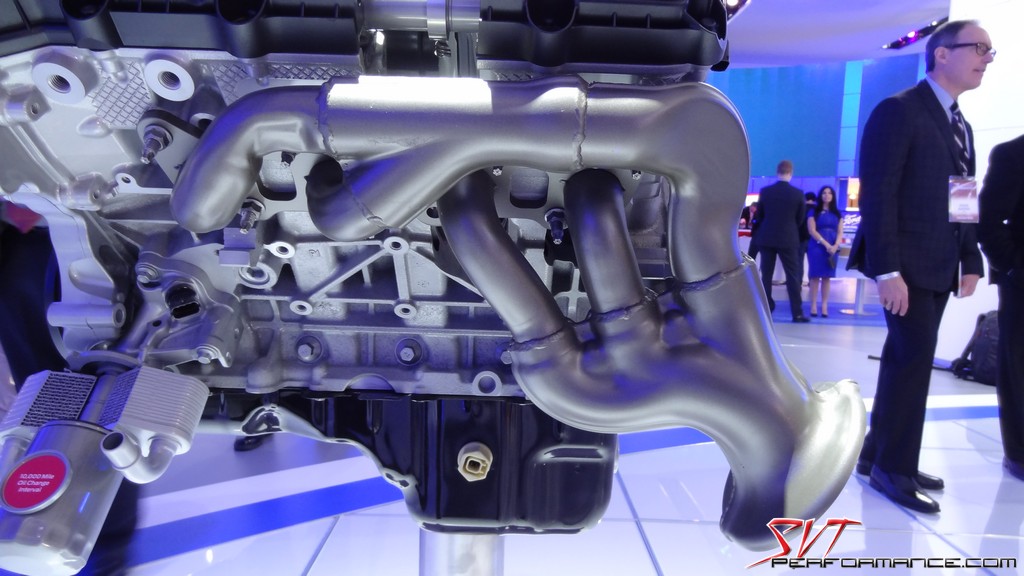
Here is a look at the 2015 Mustang's new independent rear suspension.
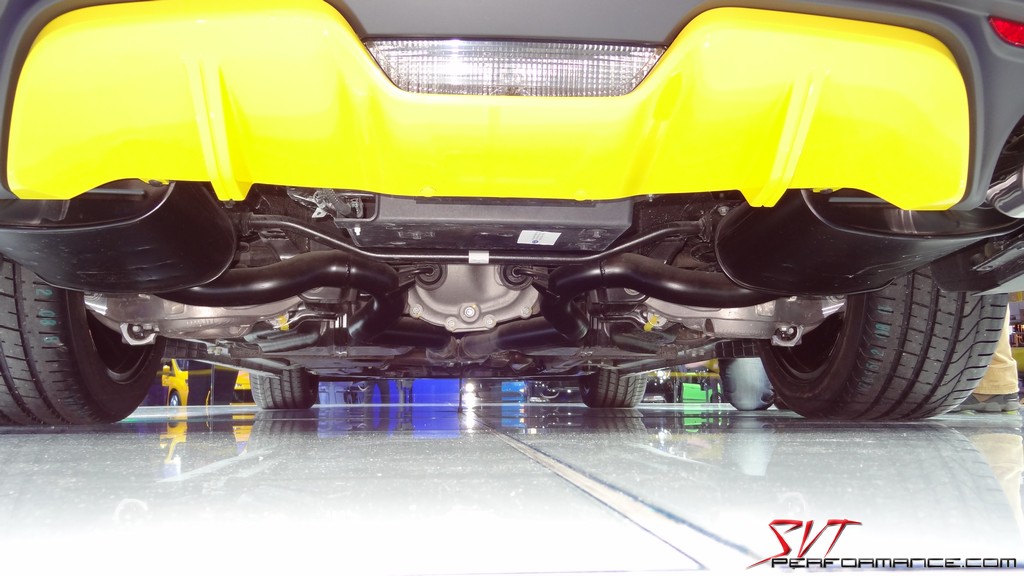
I'm glad to see that the differential cover has a drain plug. I hope this version is stronger than the one found in the 99-04 Cobras.

The 1.0L EcoBoost has been a huge success globally.
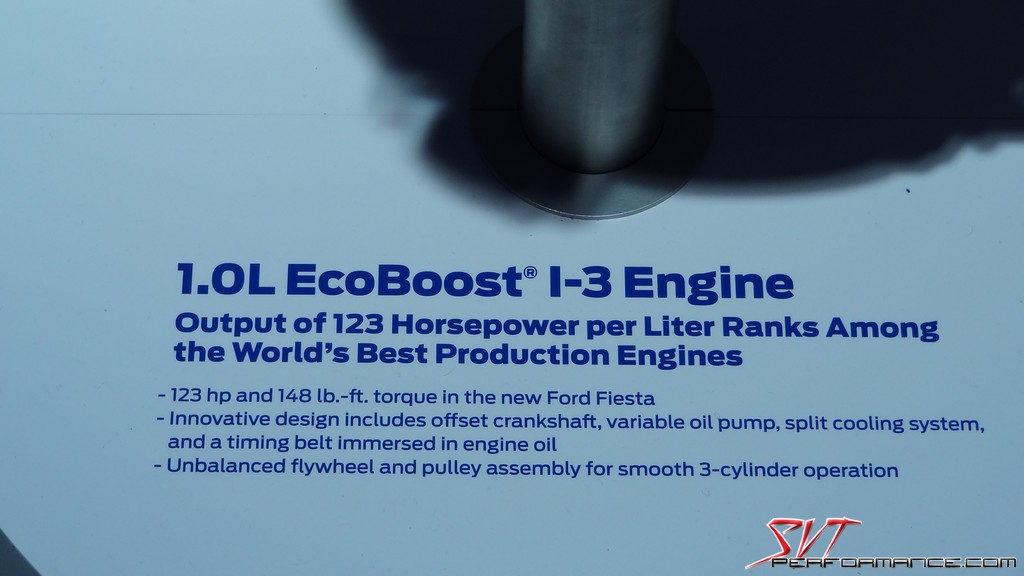
The I-3 is certainly a compact package.
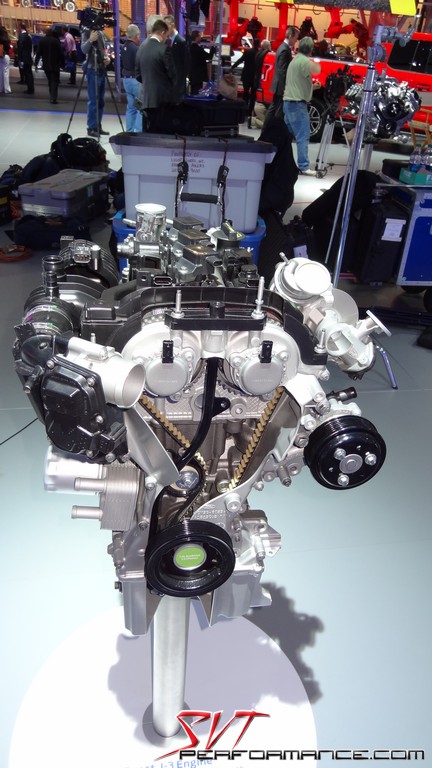
It's surprising to see that Ford recommends Castrol oil for the 1.0L. It's probably due to the engine's European origins.
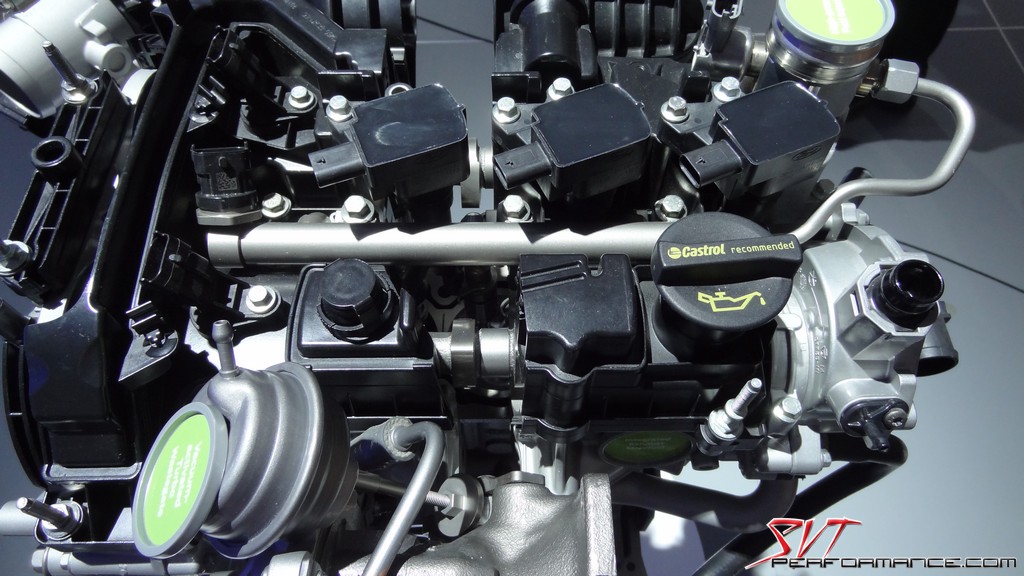
This turbo is insanely small.
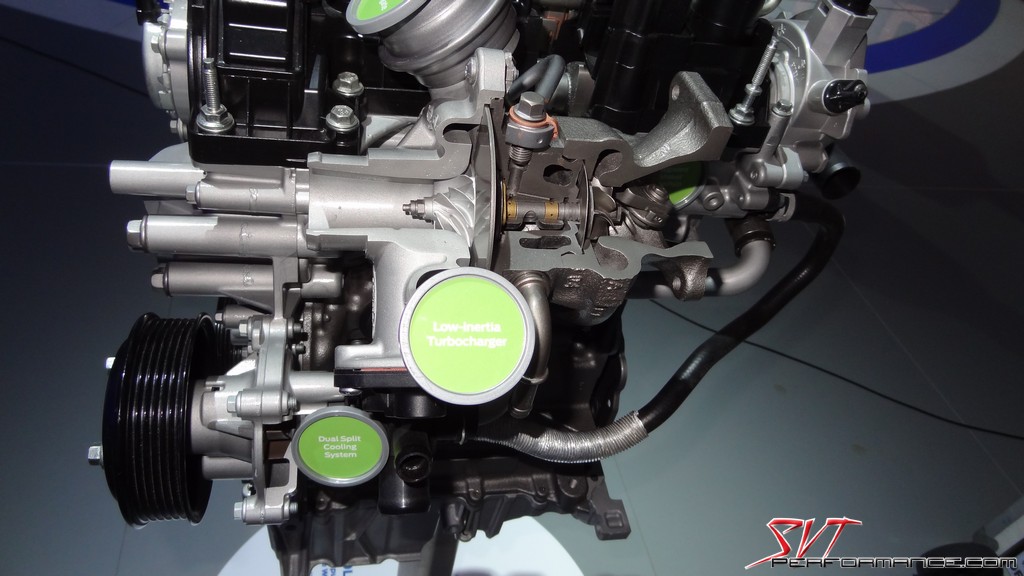
The inducer is barely one knuckle wide (not a standard unit of measure).
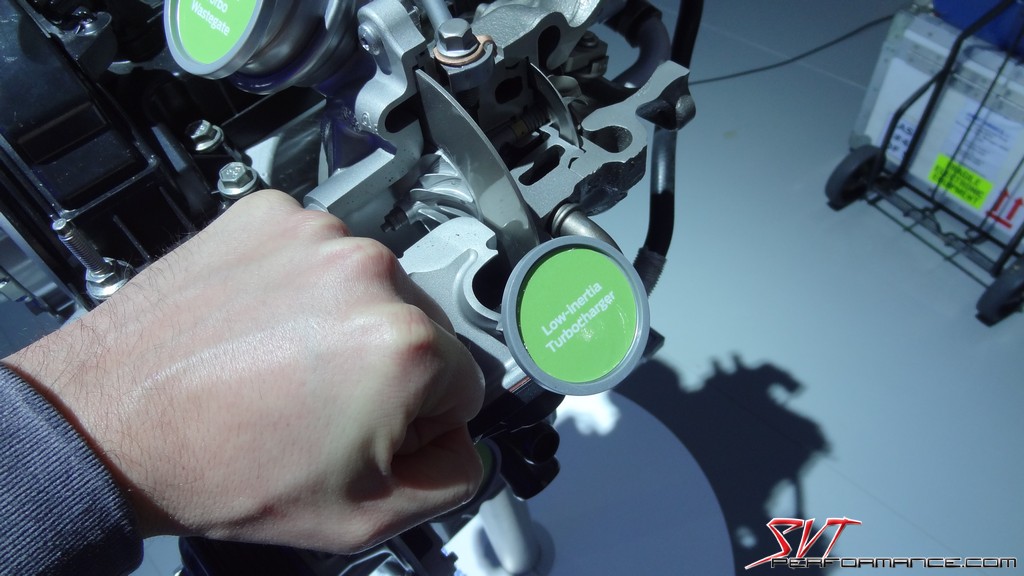
This little wheel is what makes it possible for the little 1.0L engine to make over 120HP and nearly 150 lbft of torque.
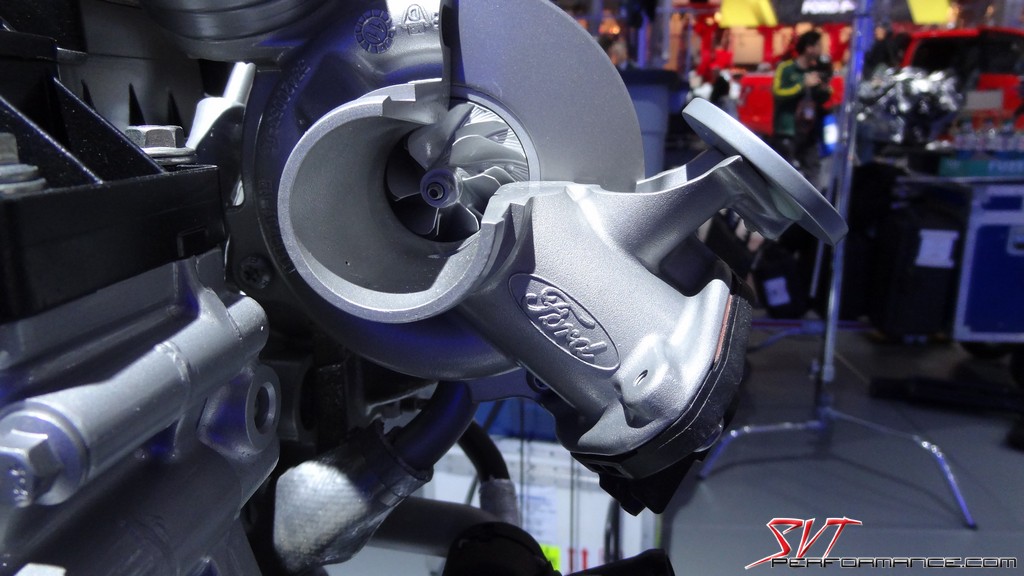
I'm not sure how fond I am of the new F-150 badge.
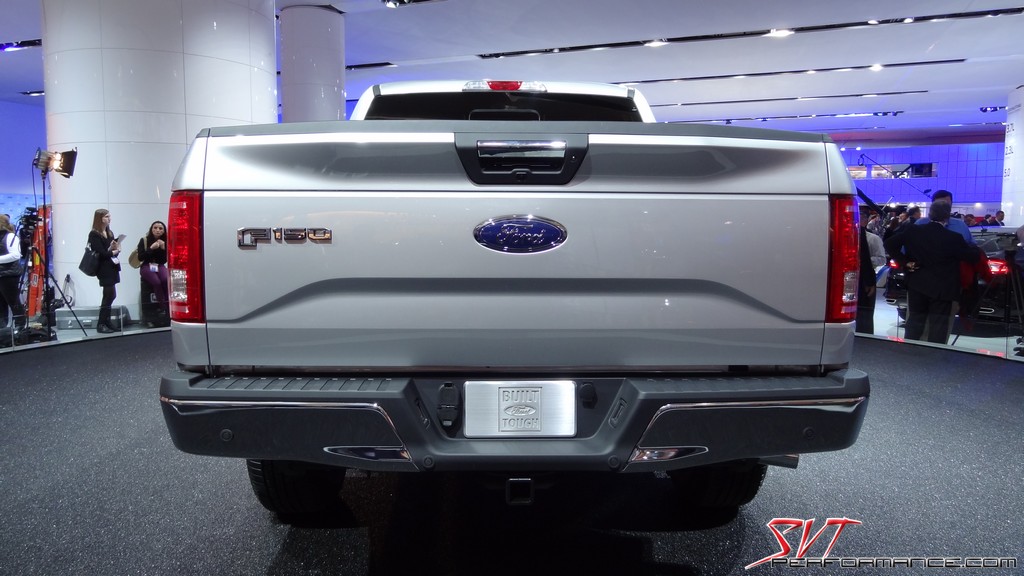
This display, a cutaway of a 2015 F-150 door, was very popular.
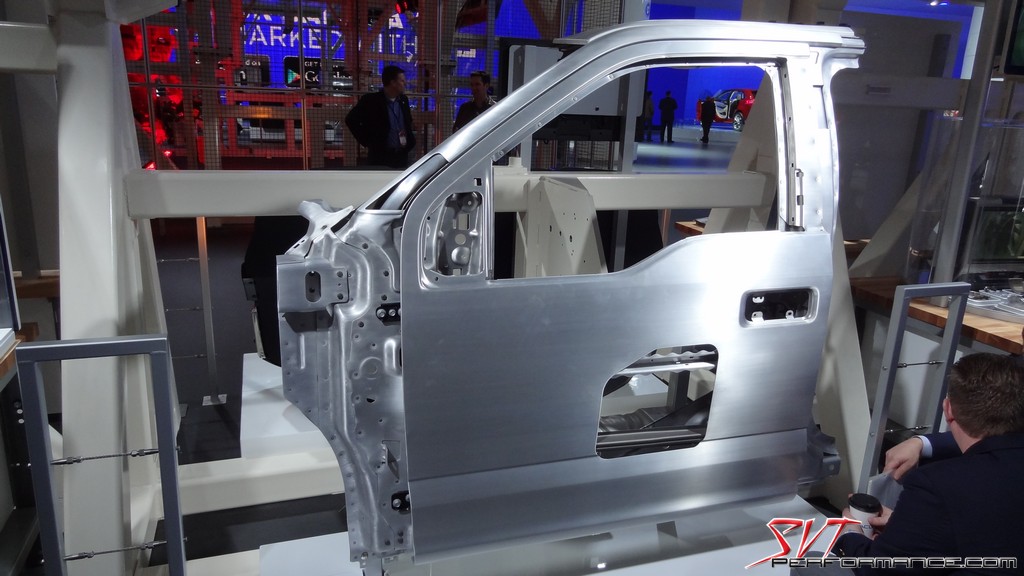
Ford knows that they're going to have to convince truck buyers that their move to aluminum body construction was the right one.
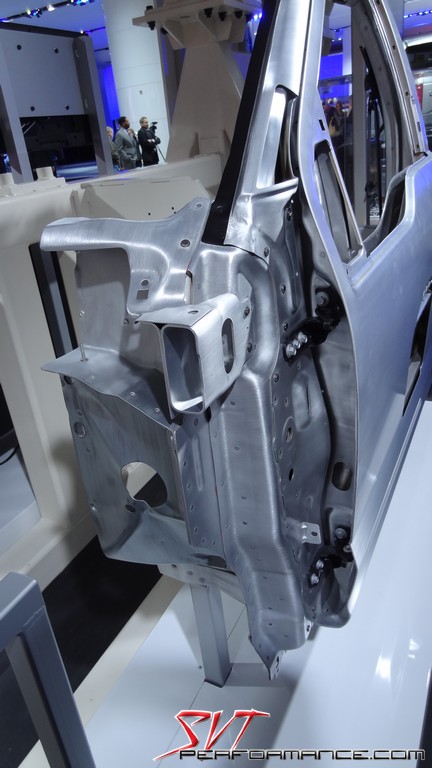
Ford engineers claim that the structure is not only far lighter than the previous generation, but also tougher.
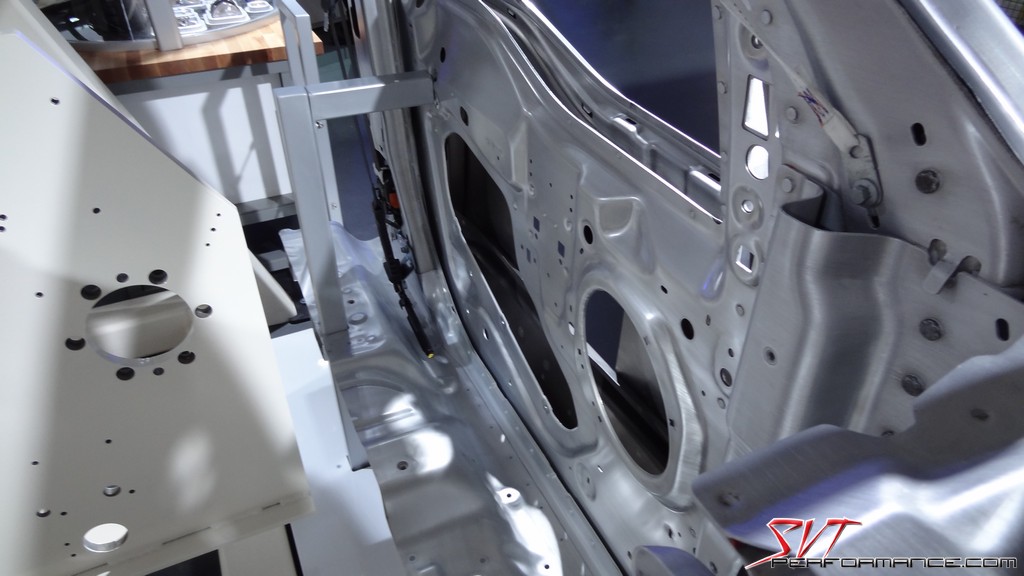
A big change is the method of construction for the F-150 body. Instead of being spot welded the panels are glued and riveted together.
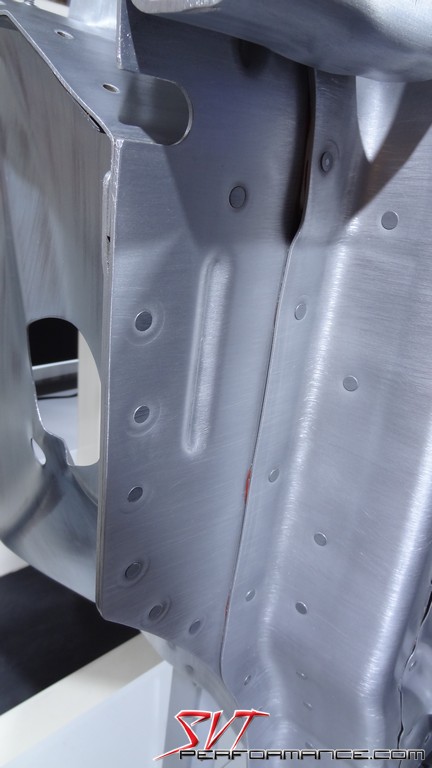
If this construction method looks familiar it may be because it is exactly the same one used by Jaguar.
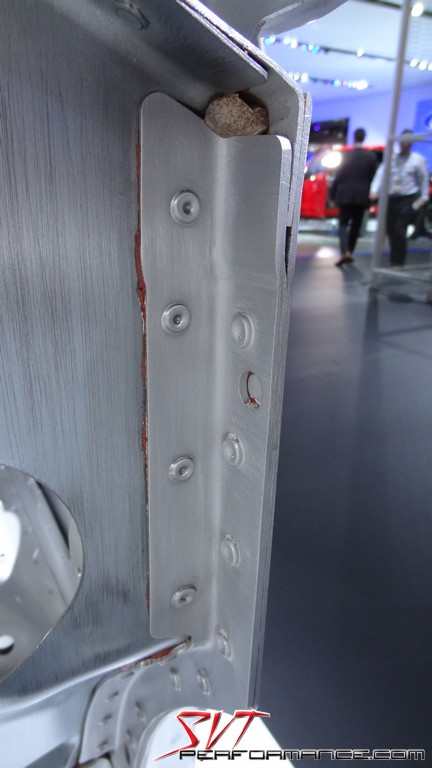
If you're worried about the aluminum body being flimsy, don't be. The section thickness of the pieces is very impressive.

Ford claims that this added thickness make the F-150's body panels much more ding resistant, as well as corrosion resistant.

All the F-150 engineers we spoke to were particularly excited about the new 2.7L EcoBoost engine.

This engine is essentially the second generation of EcoBoost technology.

EcoBoost engines tend to be very compact in size relative to their power output, and this one should be no exception.
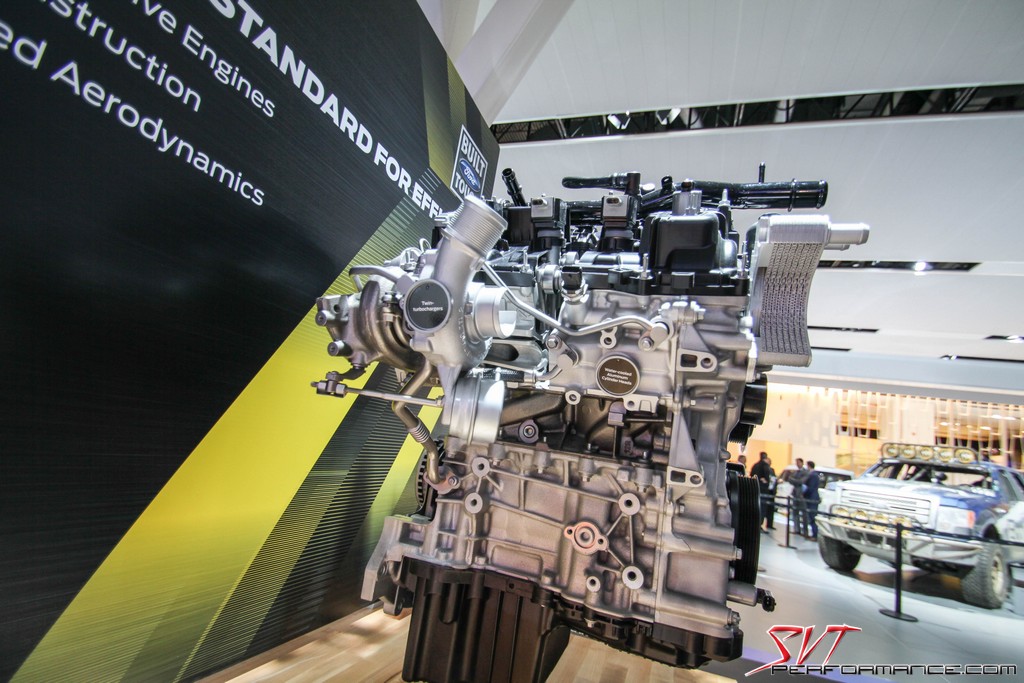
Ford ran this engine in a Baja race truck where it performed beyond the engineer's expectations. This is supposed to be one tough little engine.

The 2.7L features a compacted graphite iron block.
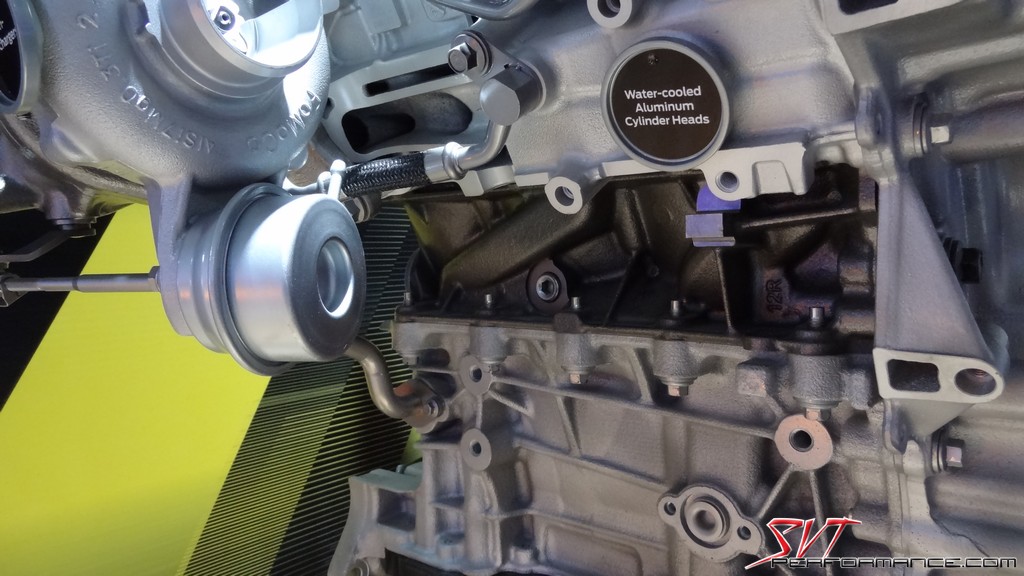
Even though the iron block looks very small, it actually extends very deeply into the aluminum girdle you can see bolted to the block here.
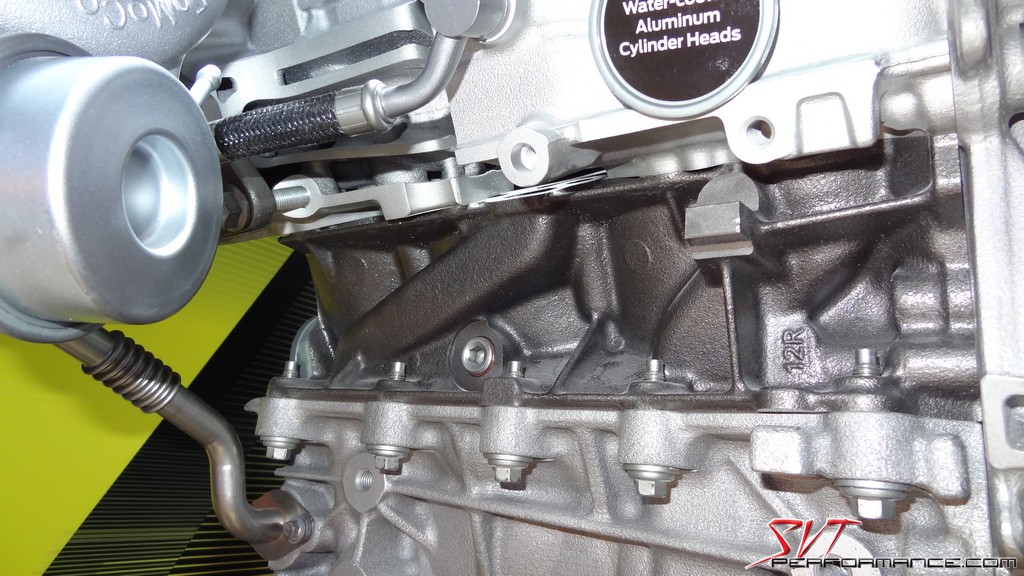
The new EcoBoost V6 also features a plastic oil pan.
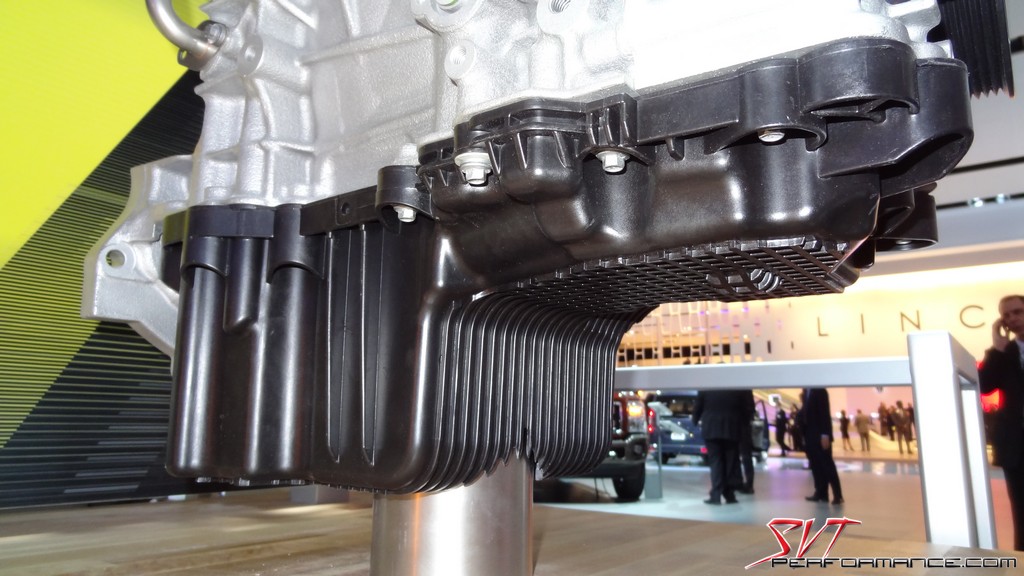
Much like the 2.3L EcoBoost the 2.7L's exhaust manifolds are integrated into the cylinder heads.

CGI is the material that Ford uses for the 6.7L Powerstroke V8 diesel block.

The integrated exhaust manifolds reduce cost, weight, and complexity.
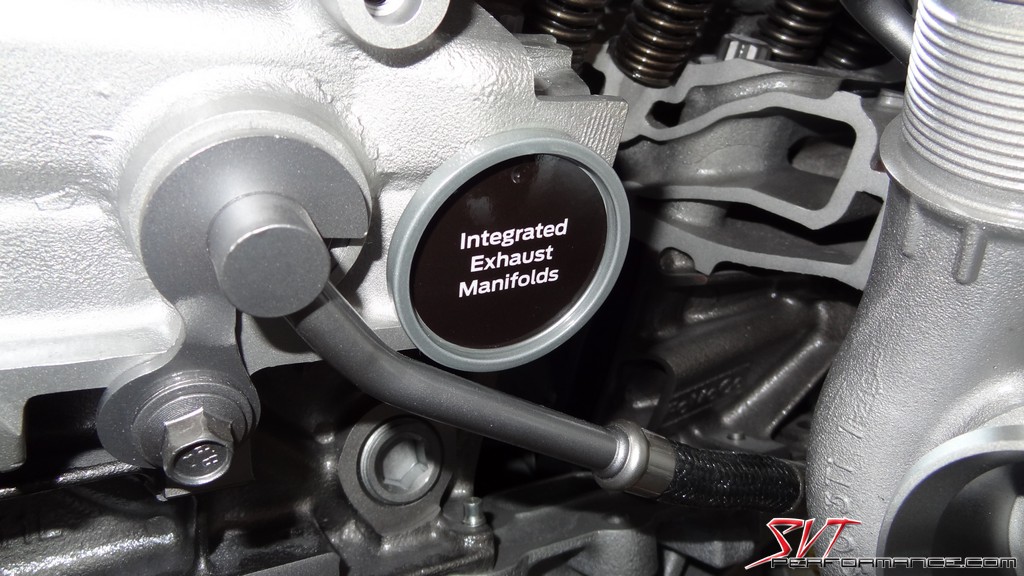
The coil packs appear to be a new design.
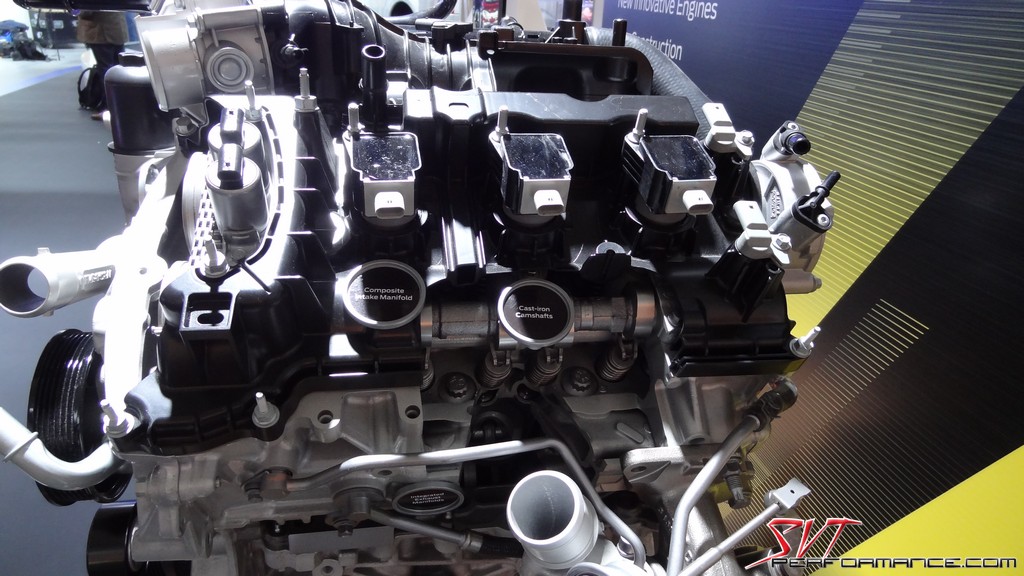
Cast iron camshafts seem to be making an appearance across all the new Ecoboost engines.

The turbos feature wastegates and liquid cooling.
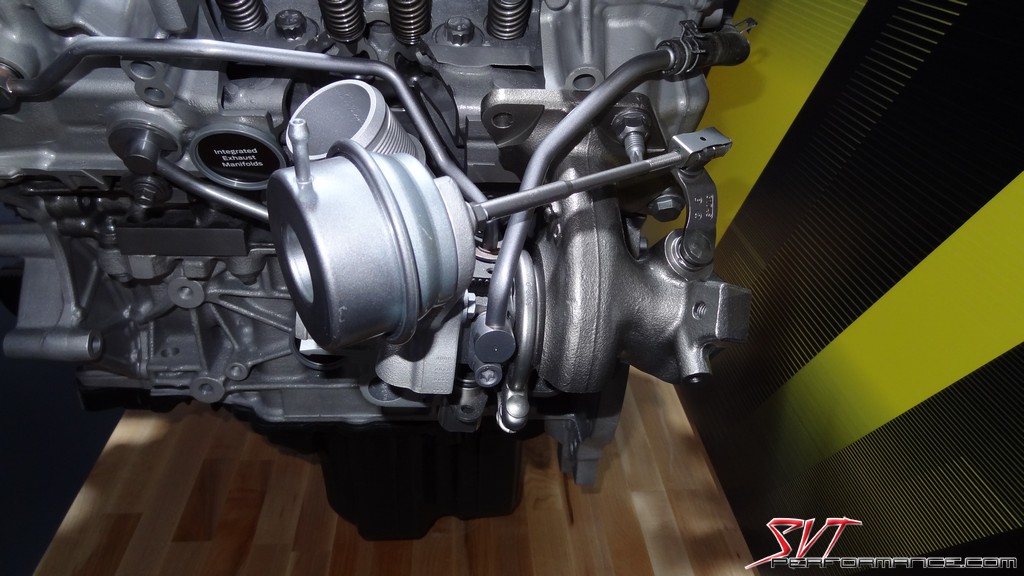
The 2.7L's intake manifold appears to be a fairly low volume design.

It'll be interesting to see how this smaller engine will perform in the all-new lighter 2015 F-150.
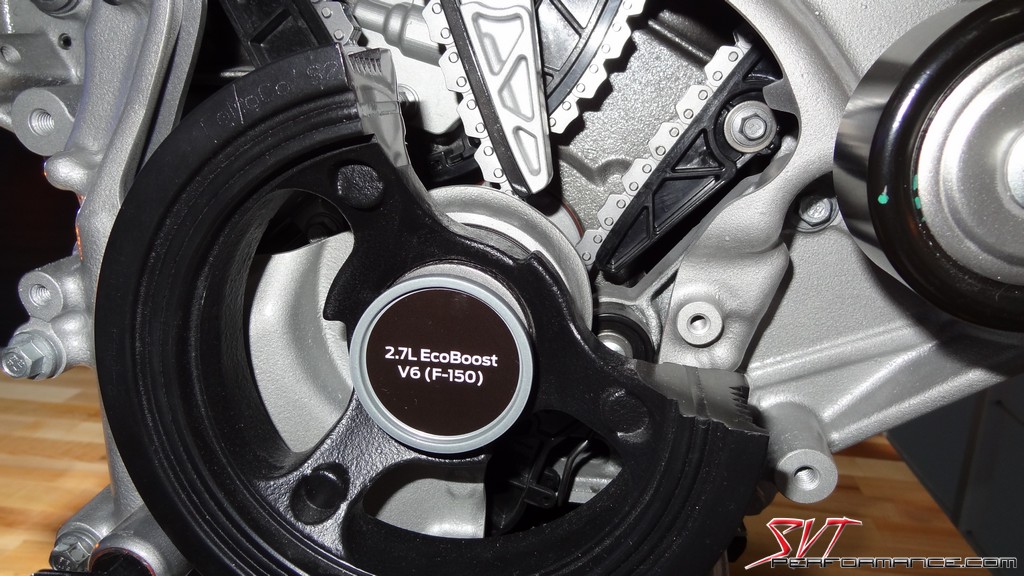
Ford wants everyone to know the lengths they went to reduce weight of the new F-150. High-strength steel and lots or aluminum are the materials of choice.
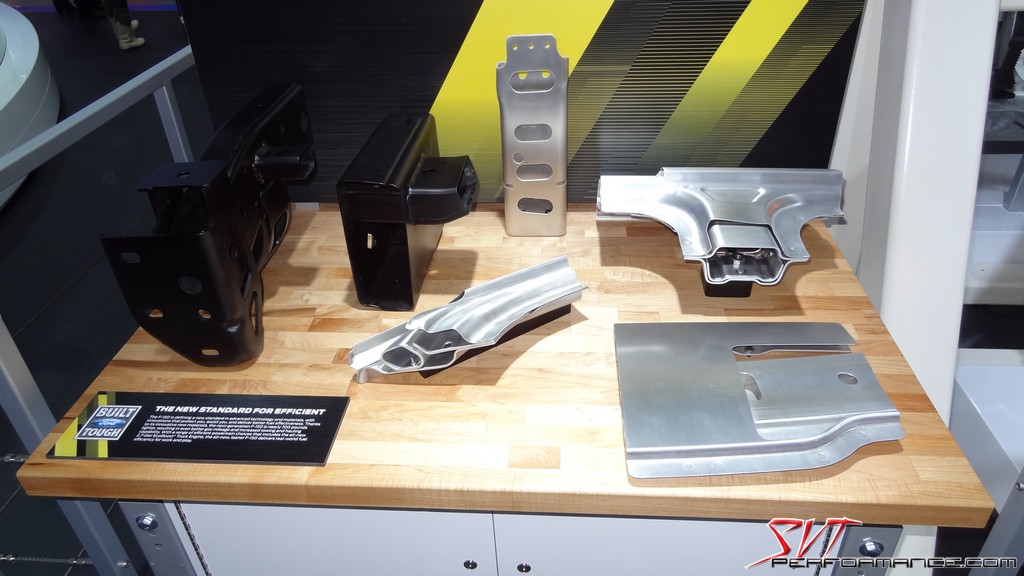
This extruded aluminum tube forms a halo through the pillars and over the top of the cab.
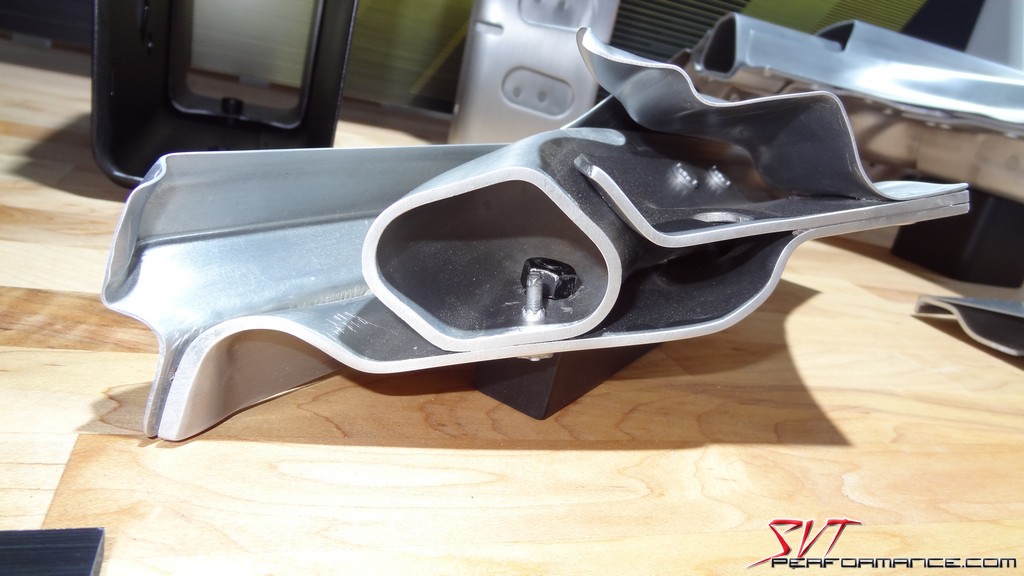
The F-150's b-pillar features several layers of aluminum. This piece is definitely beefy.
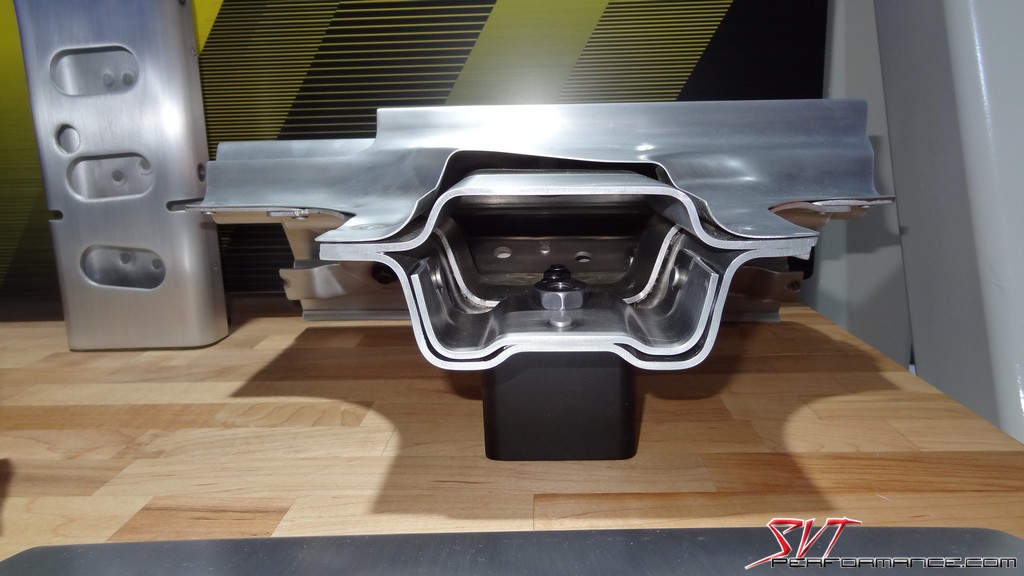
This is the header panel on the cab (the piece of the roof where the windshield attaches). It also sports a substantial aluminum extrusion.

This is the truck version of the Coyote V8 that will grace the frame rails of the 2015 F-150.

Due to the expected hard usage of truck engines the 5.0L truck engines come standard with an oil cooler.
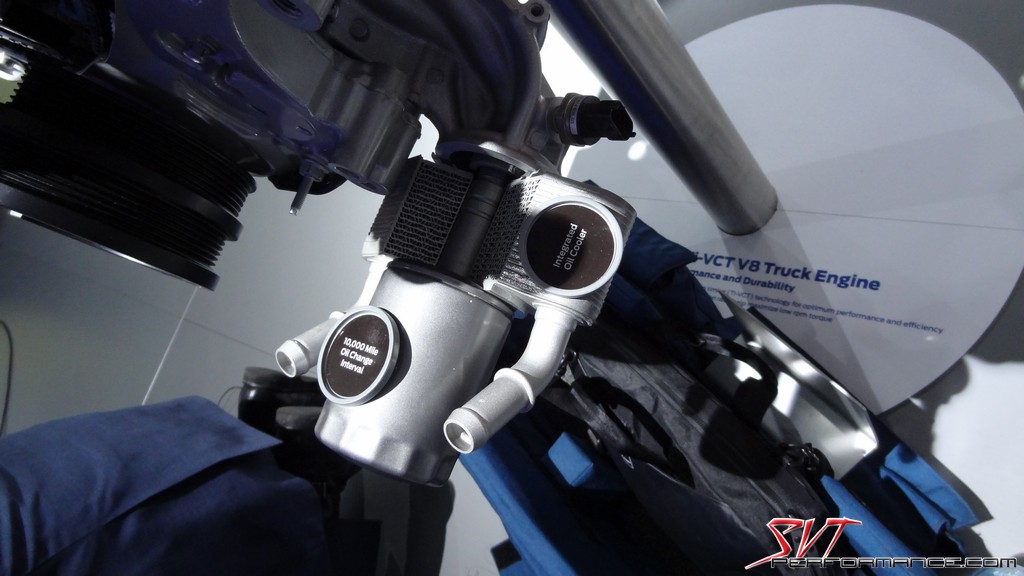
These variable camshafts are one of the reasons the Coyote makes such great power.
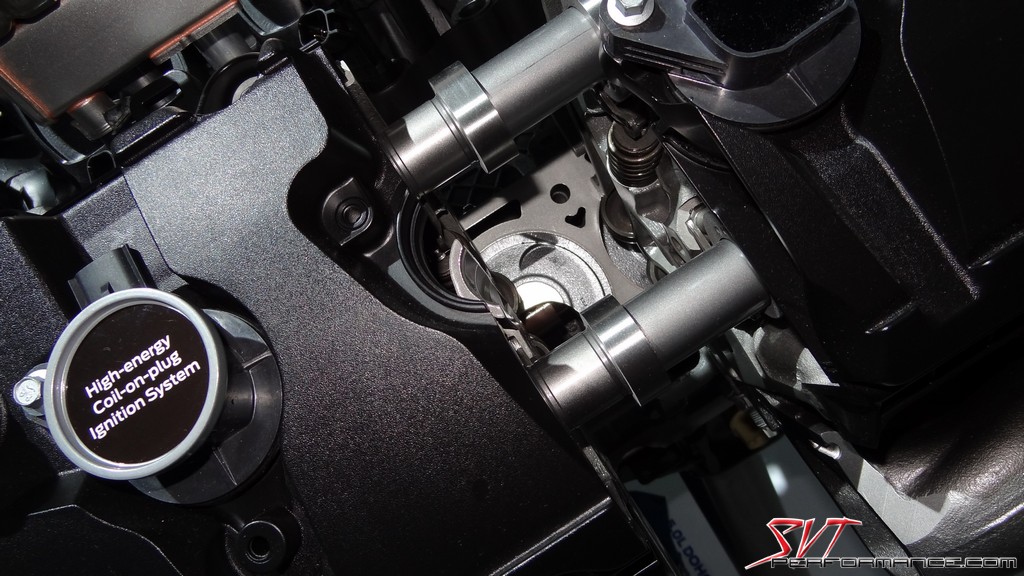
For 2015 Ford upgraded the truck Coyote's log-style exhaust manifolds to these cast iron versions of the Mustang's headers.
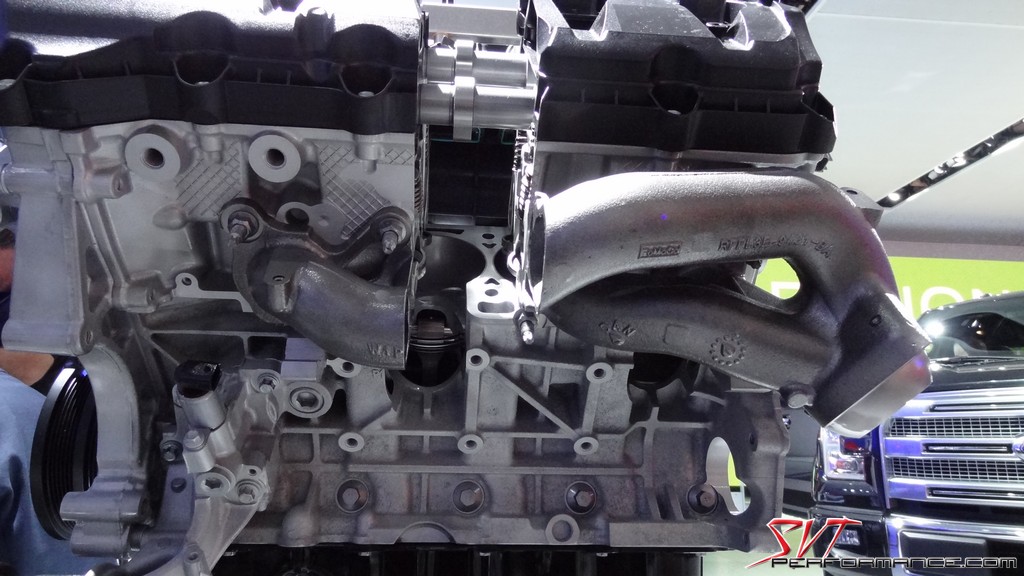
Like the 2015 Mustang, the 2015 F-150 will get an upgraded intake manifold that is equipped with charge-motion-control-valves.
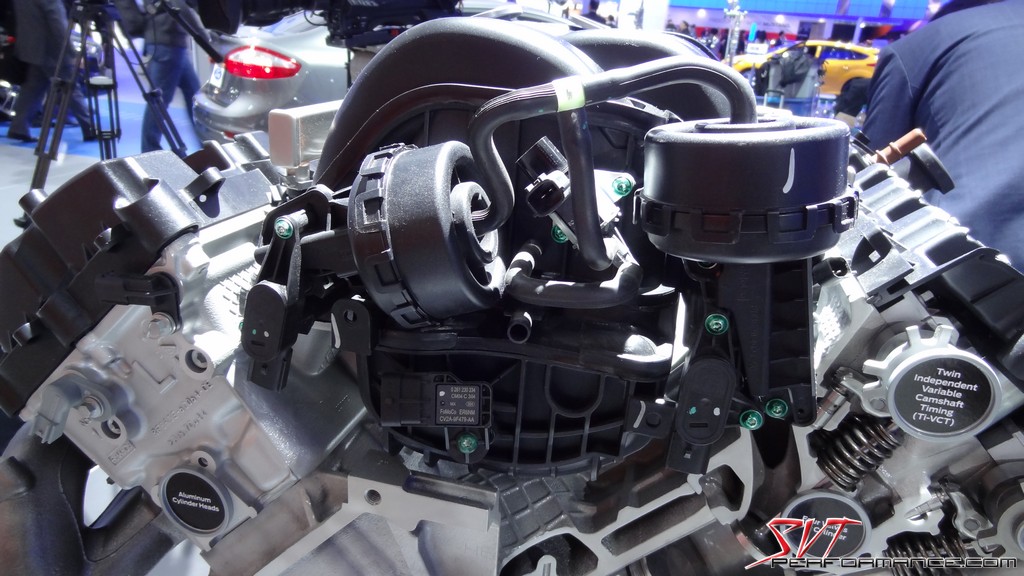
These vacuum actuators control the valves.
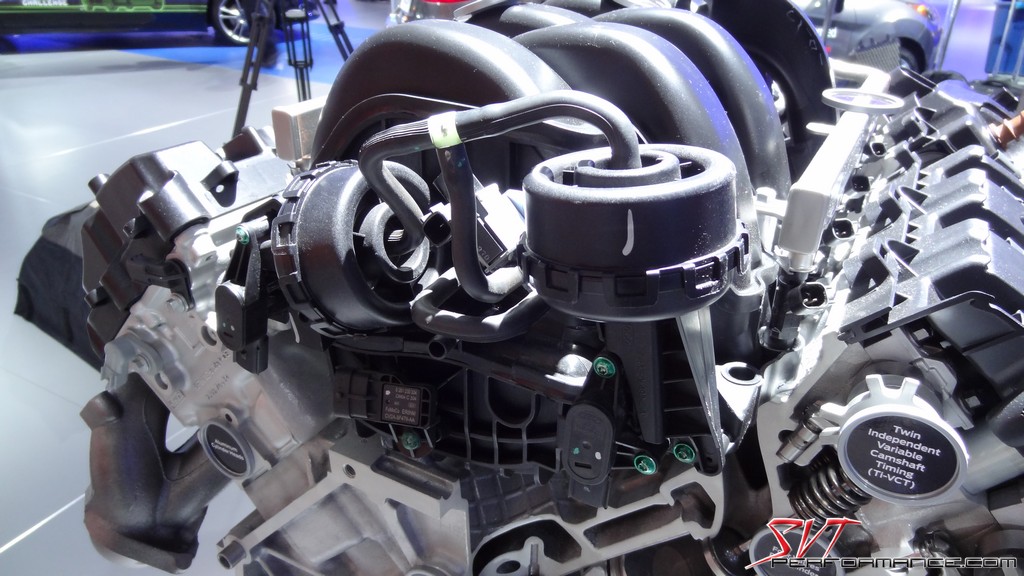
The Coyote is a somewhat complicated engine, but it sure does make great power.
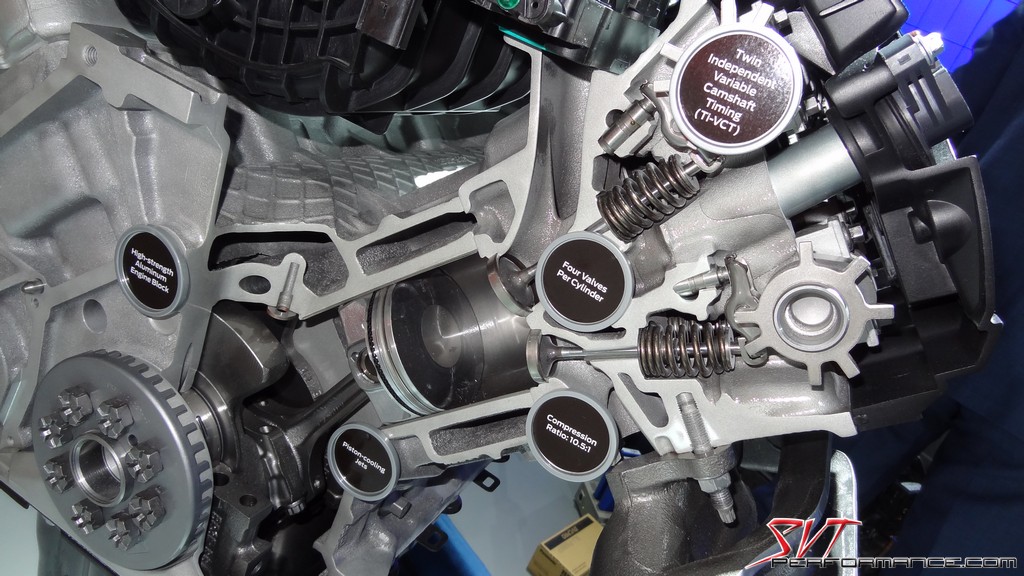
Due to the heavy use truck owners put their engines through Ford installs piston-cooling oi jets in the 5.0.
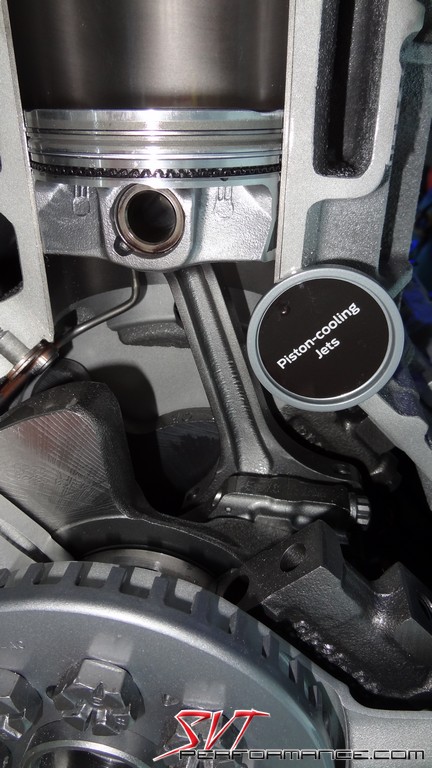
The massive runners of the new intake should ensure great airflow and power in the upper RPM range. The high volume of the intake should aid low RPM torque production.
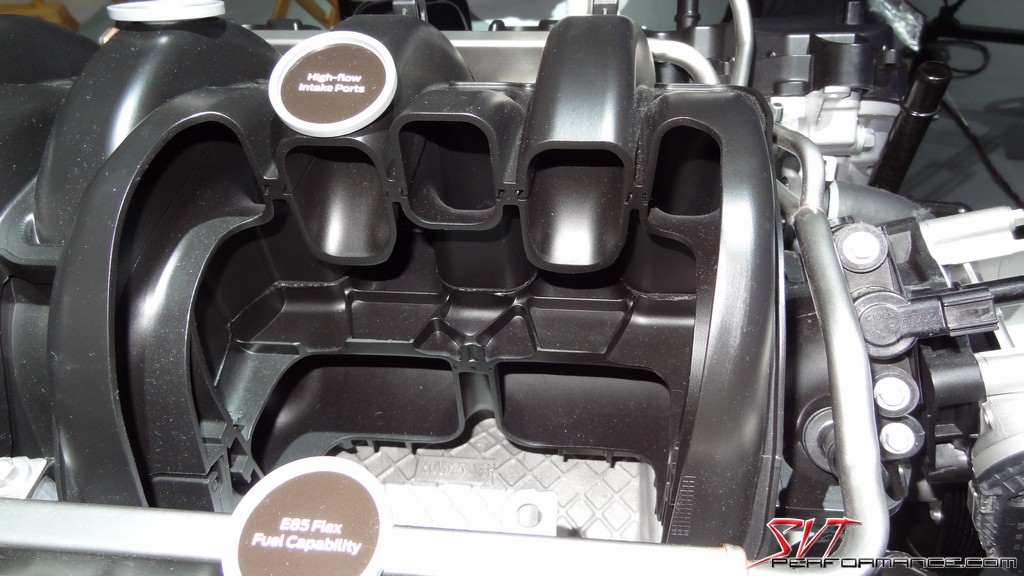
The charge motion control valves should increase the air velocity in the low RPM range.

I'm really interested to see what the final power output figures from the upgraded Coyotes.
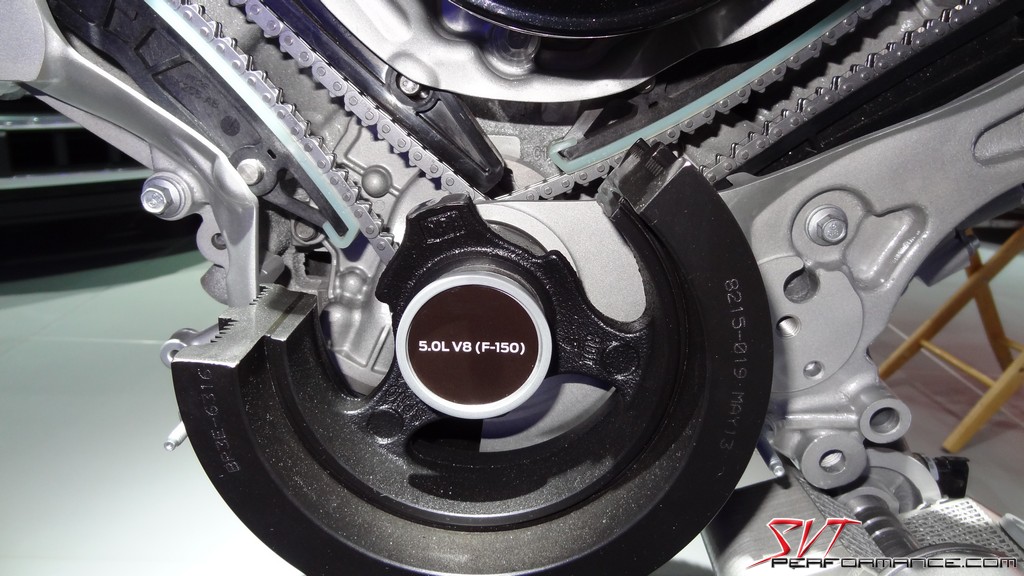
These cast iron headers are certainly good looking pieces.
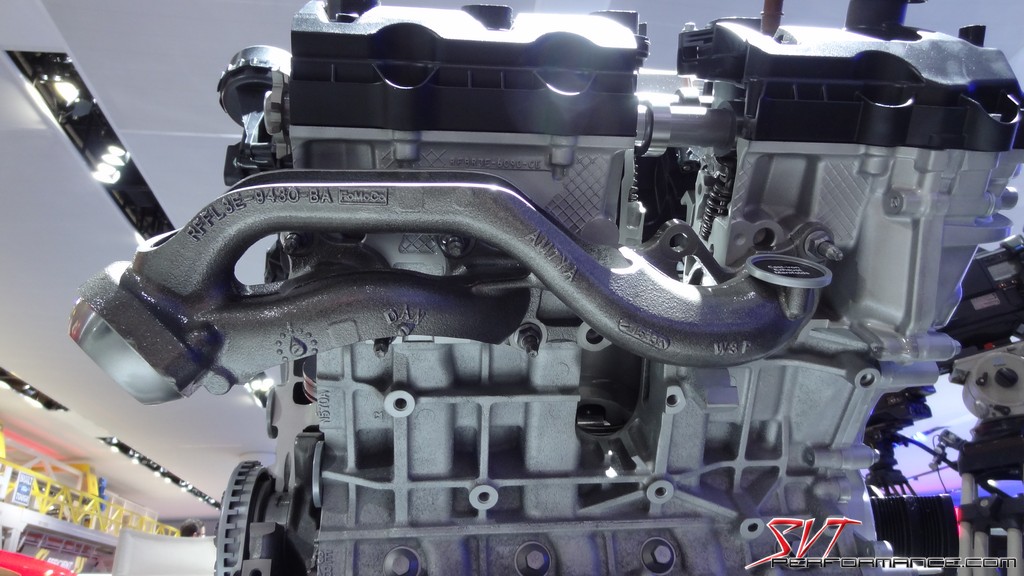
The 2015 F-150's rear suspension is very similar to the out going model.
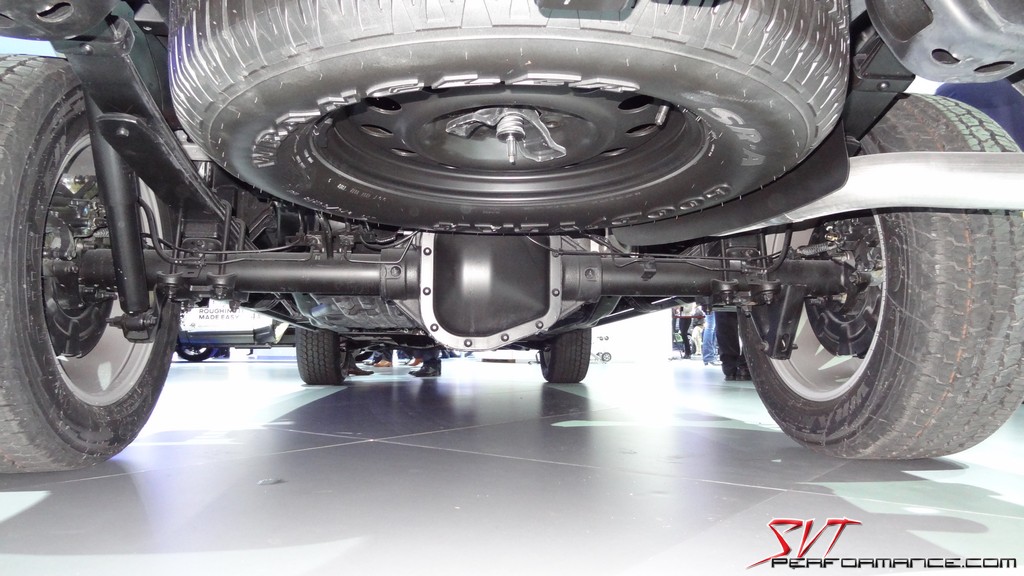
The front suspension design is familiar as well.
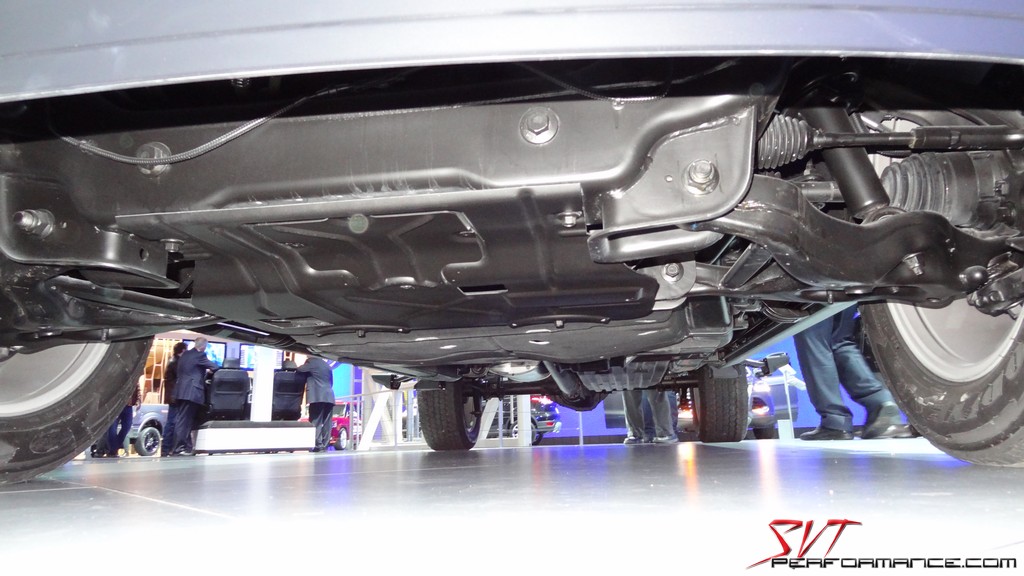
The control arms are a new design that looks somewhat like a steel version of the Raptor arms.
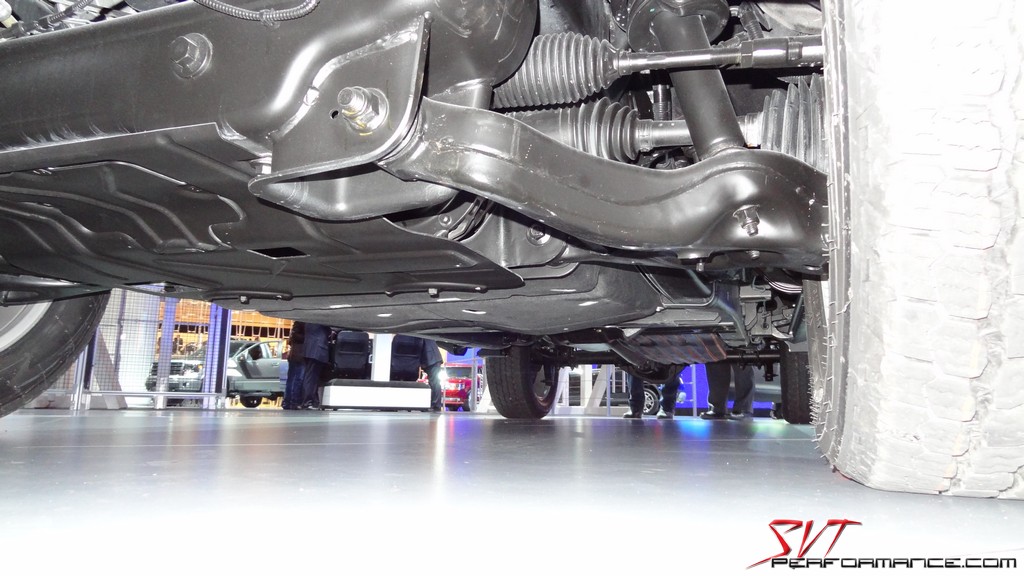
The upper control arms are now made from welded steel stampings instead of cast iron.

The thickness of these coils is quite impressive. I wonder if they are hollow.
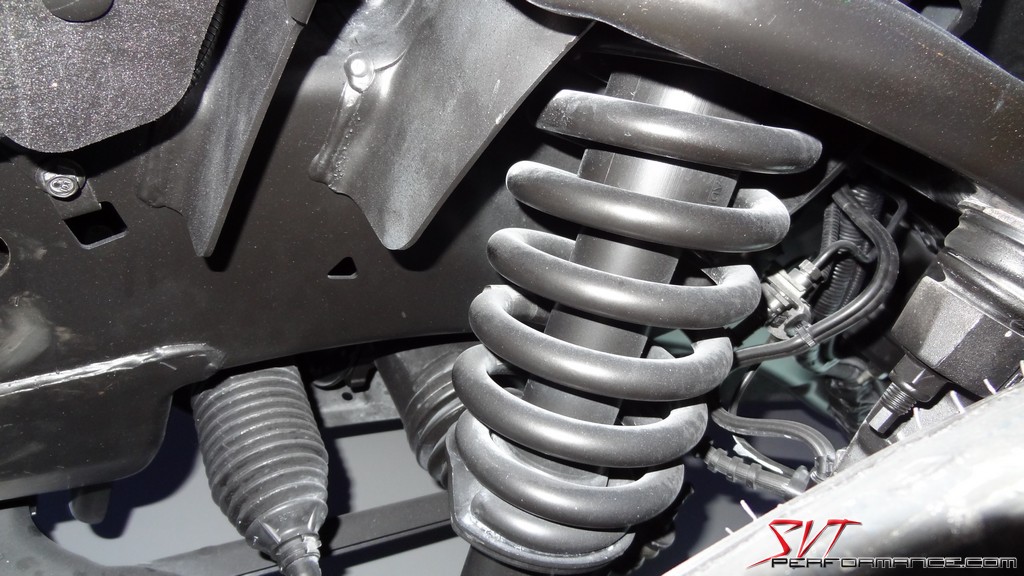
I suspect the 2015 F-150's front suspension may make a good platform for a performance model.
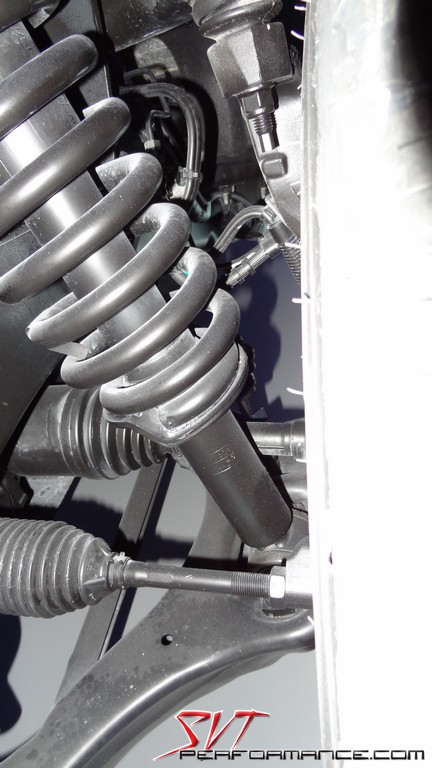
I'm a big fan of the 2015 F-150's headlights.
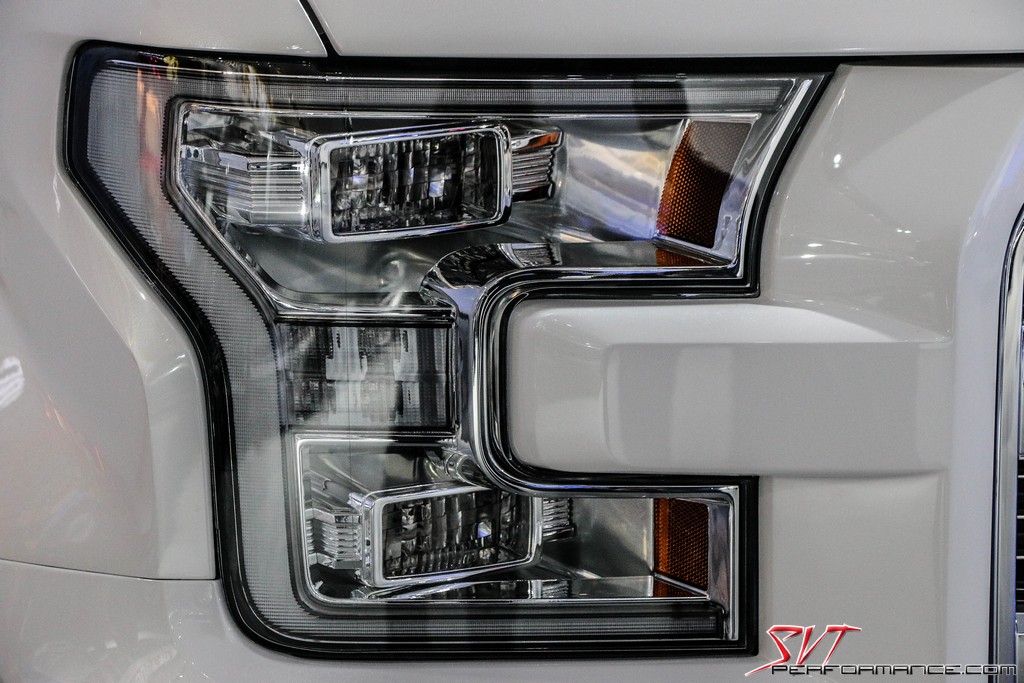
To me, they are a massive improvement over the previous model.
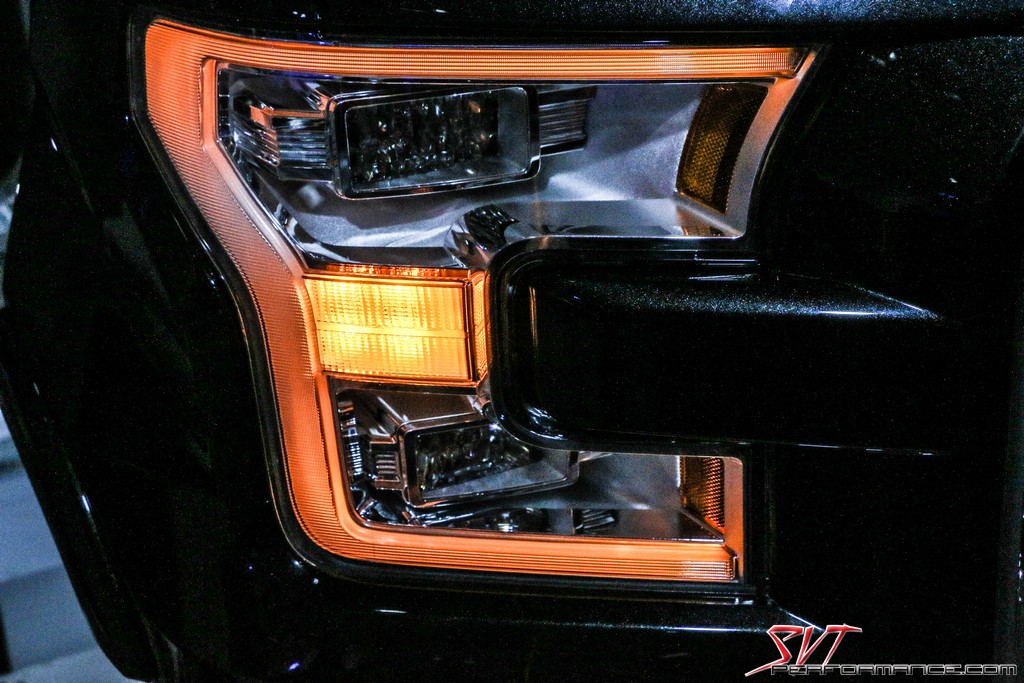
For improved aerodynamics and better fuel economy the F-150 will come equipped with active grill shutters.
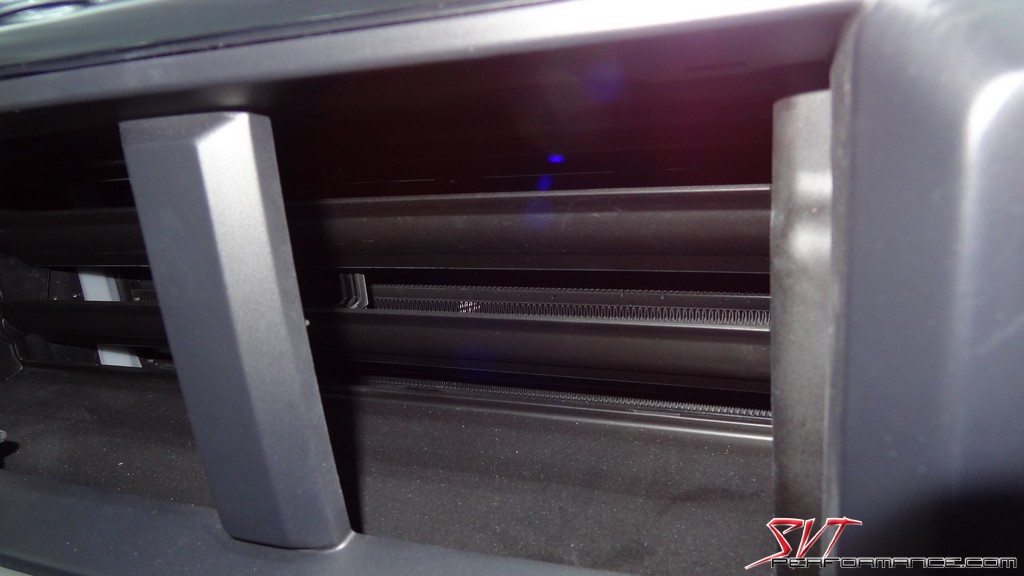
They extend the full length and width of the grill.

The truck has also adopted the Raptor's front camera.
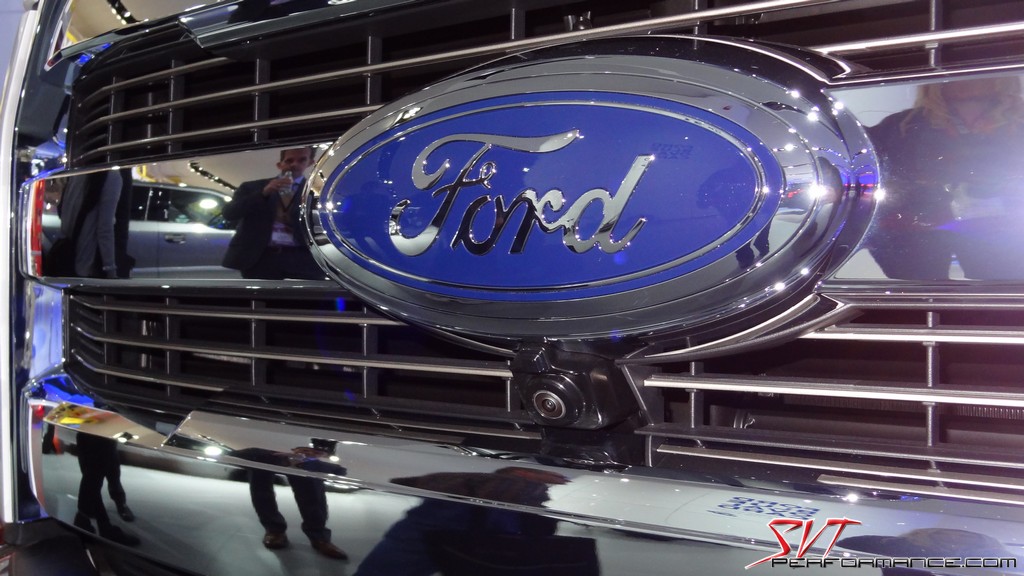
The sunroof is massive, and from this angle the truck reminds me a bit of the Super Chief concept from several years ago.

I'm glad to see that Mr. Fusion is now a standard feature on Doc. Brown's DeLorean. Keeping a ready supply of plutonium was becoming a real pain.
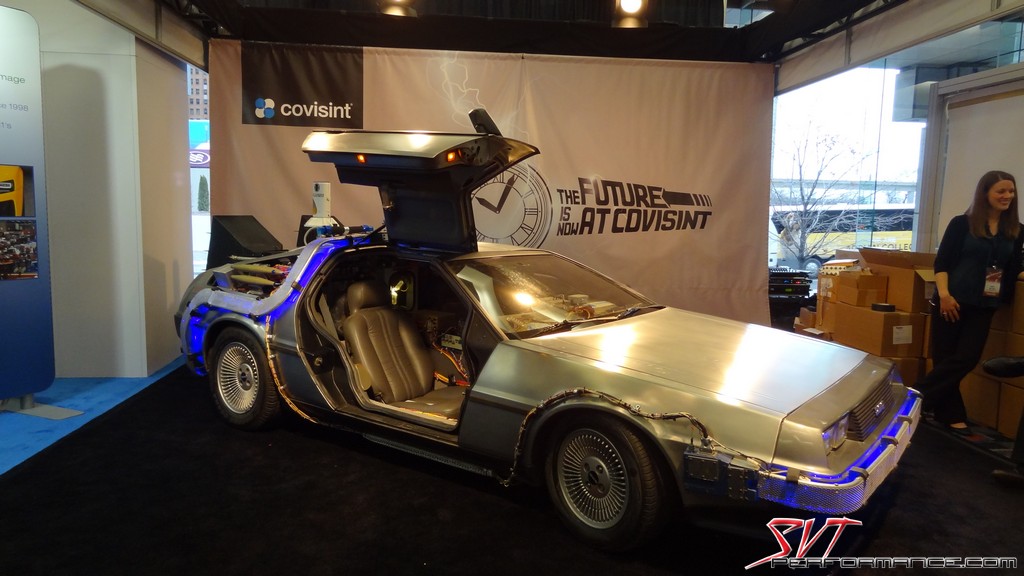

The above panel's lighter counterpart features several aluminum extrusions.

This single roof panel manufactured with aluminum in place of steel saves over 25 pounds.

Taking it a step further, Ford also had a similar panel made with magnesium extrusions.

Here you can see its construction.

Ford has been looking in places you may not think of in order to cut weight. One o these HVAC ducts is made from plastic, the other is foam and it easily weighted half as much as the other.

In a few years you may be seeing carbon fiber wheels offered on Fords.

Titanium springs may be a bit cost prohibitive on a main line vehicle, but I could see them being offered in an application where every pound counts.

A synthetic composite, fiber glass for lack of a better term, is a very interesting proposition.

Ford has invested heavily in its rabid prototyping capabilities. It allows for much faster development at a substantially lower cost than traditional methods.

This is the 1.0L EcoBoost I-3 engine block. Word is a Ford engineer took one of these to Europe in a carry-on bag.

This is a cut-away model of the 2.3L EcoBoost I-4 that will be available in the 2015 Mustang.

The 2.3L has a balance shaft that is chain driven off the crankshaft.

It's composite manifold is a well made piece that almost looks like half of a Cobra Jet intake manifold.

Just like the Coyote V8, the EcoBoost features Ford's Twin Independent Variable Camshaft Timing system.

The I-4 also sports cast iron camshafts.

Sadly, the little turbo engine does not appear to come with an integrated oil cooler.

This module on the back of the cylinder head appears to be a vacuum pump.

The EcoBoost's high-pressure fuel pump has a roller lifter that rides on its own dedicated four-peak camshaft lobe.

I'm glad to see an aluminum casting used for this coolant line.

The Mustang version of this engine is supposed to feature a forged crankshaft and forged rods, which should make it pretty stout.

The EcoBoost lacks a traditional exhaust manifold. By casting it into the head Ford saves weight and cost.

This turbo should make for an excellent torque curve.

It may be small, but it should pack a nice punch.

Here you can see the twin-scroll design of the exhaust housing.

Looks like the EcoBoost will have a 6 bolt crank.

The 2.3's rods have a tapered small end that is very similar to those found in the 5.8L Trinity engine in the 2013-14 SVT Shelby GT500 Mustang.

This is one of the EcoBoost's direct injectors.

Looks like the S550 code name has made its official debut.

The combustion chamber of the 2.3L EcoBoost.

An up-close look of a 2.3's connecting rod.

It looks like Ford has high hopes for this engine in the Mustang platform.

The Mustang's 3.7L V6 appears to be unchanged.

We know that the 2015 Mustang's Coyote V8 will be receiving a new intake manifold, but this seems to be the same engine model we have seen since the Coyote's debut.

You can see a piston oil squirter that the Coyote featured in the 2011 and 2012 model years.

The Coyote block has decently thick cylinder walls.

This engine has been the most popular performance platform in the Mustang since the original 5.0L V8.

An oil cooler is a good upgrade if your Mustang didn't come with one from the factory.

This doesn't appear to be the final production version of the the Coyote's headers.

Here is a look at the 2015 Mustang's new independent rear suspension.

I'm glad to see that the differential cover has a drain plug. I hope this version is stronger than the one found in the 99-04 Cobras.

The 1.0L EcoBoost has been a huge success globally.

The I-3 is certainly a compact package.

It's surprising to see that Ford recommends Castrol oil for the 1.0L. It's probably due to the engine's European origins.

This turbo is insanely small.

The inducer is barely one knuckle wide (not a standard unit of measure).

This little wheel is what makes it possible for the little 1.0L engine to make over 120HP and nearly 150 lbft of torque.

I'm not sure how fond I am of the new F-150 badge.

This display, a cutaway of a 2015 F-150 door, was very popular.

Ford knows that they're going to have to convince truck buyers that their move to aluminum body construction was the right one.

Ford engineers claim that the structure is not only far lighter than the previous generation, but also tougher.

A big change is the method of construction for the F-150 body. Instead of being spot welded the panels are glued and riveted together.

If this construction method looks familiar it may be because it is exactly the same one used by Jaguar.

If you're worried about the aluminum body being flimsy, don't be. The section thickness of the pieces is very impressive.

Ford claims that this added thickness make the F-150's body panels much more ding resistant, as well as corrosion resistant.

All the F-150 engineers we spoke to were particularly excited about the new 2.7L EcoBoost engine.

This engine is essentially the second generation of EcoBoost technology.

EcoBoost engines tend to be very compact in size relative to their power output, and this one should be no exception.

Ford ran this engine in a Baja race truck where it performed beyond the engineer's expectations. This is supposed to be one tough little engine.

The 2.7L features a compacted graphite iron block.

Even though the iron block looks very small, it actually extends very deeply into the aluminum girdle you can see bolted to the block here.

The new EcoBoost V6 also features a plastic oil pan.

Much like the 2.3L EcoBoost the 2.7L's exhaust manifolds are integrated into the cylinder heads.

CGI is the material that Ford uses for the 6.7L Powerstroke V8 diesel block.

The integrated exhaust manifolds reduce cost, weight, and complexity.

The coil packs appear to be a new design.

Cast iron camshafts seem to be making an appearance across all the new Ecoboost engines.

The turbos feature wastegates and liquid cooling.

The 2.7L's intake manifold appears to be a fairly low volume design.

It'll be interesting to see how this smaller engine will perform in the all-new lighter 2015 F-150.

Ford wants everyone to know the lengths they went to reduce weight of the new F-150. High-strength steel and lots or aluminum are the materials of choice.

This extruded aluminum tube forms a halo through the pillars and over the top of the cab.

The F-150's b-pillar features several layers of aluminum. This piece is definitely beefy.

This is the header panel on the cab (the piece of the roof where the windshield attaches). It also sports a substantial aluminum extrusion.

This is the truck version of the Coyote V8 that will grace the frame rails of the 2015 F-150.

Due to the expected hard usage of truck engines the 5.0L truck engines come standard with an oil cooler.

These variable camshafts are one of the reasons the Coyote makes such great power.

For 2015 Ford upgraded the truck Coyote's log-style exhaust manifolds to these cast iron versions of the Mustang's headers.

Like the 2015 Mustang, the 2015 F-150 will get an upgraded intake manifold that is equipped with charge-motion-control-valves.

These vacuum actuators control the valves.

The Coyote is a somewhat complicated engine, but it sure does make great power.

Due to the heavy use truck owners put their engines through Ford installs piston-cooling oi jets in the 5.0.

The massive runners of the new intake should ensure great airflow and power in the upper RPM range. The high volume of the intake should aid low RPM torque production.

The charge motion control valves should increase the air velocity in the low RPM range.

I'm really interested to see what the final power output figures from the upgraded Coyotes.

These cast iron headers are certainly good looking pieces.

The 2015 F-150's rear suspension is very similar to the out going model.

The front suspension design is familiar as well.

The control arms are a new design that looks somewhat like a steel version of the Raptor arms.

The upper control arms are now made from welded steel stampings instead of cast iron.

The thickness of these coils is quite impressive. I wonder if they are hollow.

I suspect the 2015 F-150's front suspension may make a good platform for a performance model.

I'm a big fan of the 2015 F-150's headlights.

To me, they are a massive improvement over the previous model.

For improved aerodynamics and better fuel economy the F-150 will come equipped with active grill shutters.

They extend the full length and width of the grill.

The truck has also adopted the Raptor's front camera.

The sunroof is massive, and from this angle the truck reminds me a bit of the Super Chief concept from several years ago.

I'm glad to see that Mr. Fusion is now a standard feature on Doc. Brown's DeLorean. Keeping a ready supply of plutonium was becoming a real pain.

-SID297:beer:



